Wonderful Town (pt. II) 1962-66 The Gay Sixties 1966-70 The Juicy Life 1971-76
Juicy Life (pt. II) 1976-80 Losing Alexandria 1981-87 The AIDS Spectacle
Losing Alexandria (pt. II) 1987-1990's
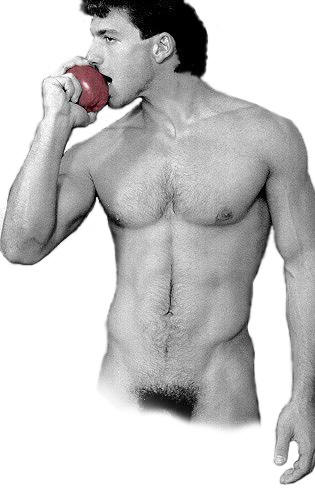
When My World Was Young 1945-56 The Yellow Brick Road 1956-60 What a Wonderful Town 1960-61
Wonderful Town (pt. II) 1962-66 The Gay Sixties 1966-70
The Juicy Life 1971-76
Juicy Life (pt. II) 1976-80
Losing Alexandria 1981-87
The AIDS Spectacle
Losing Alexandria (pt. II) 1987-1990's

the JUICY LIFE
1970 - 1974
Lush Life is a classic torch song which has been recorded by many jazz vocalists. It was written in 1938 by Billy Strayhorn and offered to bandleader Duke Ellington; a year later the openly gay Strayhorn had become his arranger and composer-in-residence. Ellington called Strayhorn, "my listener, my most dependable appraiser [and] critic." Lush Life is a sardonic lament for a life of luxury, sex and parties.
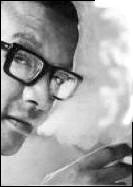 Billy Strayhorn
Billy Strayhorn
It was rather odd that this old song was recorded by Donna Summer of all people in the early 80s done in a fairly straightforward fashion and plunked down in the middle of the disco diva's new album.
Or was it so odd?
Strayhorn's wry label "lush life" may have been appropriate to his time, but in the 70's some gay men created a lifestyle that was beyond lush. The era when gay men ornamented their subculture with borrowings and fantasies from the world of entertainment and cafι society, and circled elite cultural and social circles like bees around flowers was falling into twilight. There was another gay style in the making, and it was a melange of the "sexual revolution," drug culture, Hippies, black music and urban attitude, Tom of Finland...add sex to taste and stir. Ironically, after this lifestyle had evolved, straights would come to it as voyeurs and hangers on, and they became the borrowers, circling around a world of gay discos, parties and resorts.
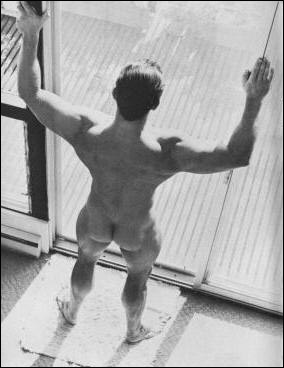
It had a quality of over-ripeness. It was the Juicy Life
For the few it ultimately became the life where more wasn't better...it was never enough.
John Tristram
That only a relatively small number of men, in a few urban areas, were totally wrapped up in living this way to the max is not the point. This lifestyle was to become in the minds of many gay men, and some straight people as well for better, and often for worse the signature of gay life.
As knowledge of the Stonewall raid and Gay Pride parade spread across the U.S. and the rest of the world the public commemorations it inspired became, as much as anything, pageants of this new urban gay lifestyle. While the events of June '69 were often known in only the vaguest way even among many New Yorkers the word "Stonewall" took on the significance of an invitation to celebrate living an openly gay life. In the city the first years of what became an annual parade saw plenty of political placards, raised fists, chanting, etc. in the Sixties style, but rather quickly especially after the marches reversed direction and ended in the Village rather than uptown a tone of joyful physicality and exuberance was predominate.
I think it would have been around 1969 that Ken brought back some copies of the Advocate from a business trip to the West Coast. And as slick gay publications began to proliferate and become available across the country what was being publicized was the way of life in places like New York and San Francisco.
THE FIRST DISCO?
In an era that encouraged eroticism and public display, combined with a new and increasing tolerance for gays e.g. liberalized laws allowing same sex dancing gay men found and eventually helped shape one stream of American pop music as an expression of their liberation. While the juke boxes in gay bars were barometers reflecting changes in gay taste, and its increasing divergence from that of mainstream white audiences, it was the dance bars, of course, which underscored that this music was for the body, not just the ears. Despite latter day vilification of bars and clubs of this era as "racist," my own personal observation was that blacks and Hispanics were a presence there, whereas they were much more rarely so in straight places. And I believe this was one of the pipelines for gay venues into the music of non-white night life. In time the dance places were providing such an overload of feedback that it killed the juke box in most gay bars in the city.
Arthur, run by Sybil Burton, ex-wife of actor Richard, opened in New York, and it was the first discotheque with a format similar to what later became standard. A "discaire" (DJ) played a thought-out mix of tunes, building a momentum that packed the floor for the climax number of the set. But it was a style that didn't really catch on with straights well perhaps because straights leaned so heavily into Rock and the discotheque idea kind of staggered along with them. And as far as gay dance places were concerned, the illegal nature of them made a juke box loaded with fifty or hundred discs a cheaper investment and one the customers kept pumping money into if they wanted to dance. Still, the pot was on the fire.
 The
prototype for the American-style disco was a place called The Sanctuary. It was
opened in 1969 before the disco era, as such, got underway. Too bad, because the
place was instantly recognizable as a new ultra-hot idea as soon as you entered
the main room. If you've ever seen the movie Klute, there is a scene
where the prostitute, Jane Fonda, is in a dance club
very brief. It was
filmed in The Sanctuary.
The
prototype for the American-style disco was a place called The Sanctuary. It was
opened in 1969 before the disco era, as such, got underway. Too bad, because the
place was instantly recognizable as a new ultra-hot idea as soon as you entered
the main room. If you've ever seen the movie Klute, there is a scene
where the prostitute, Jane Fonda, is in a dance club
very brief. It was
filmed in The Sanctuary.
(right) The Sanctuary
Unfortunately, they cut all the scenes which show how huge the place was and it's rather unusual decor and customers. It had once been a large Baptist church and its interior was kept fairly intact. The huge pipe organ still filled the front of the church. The pews had been ripped out to make a dance floor where the congregation used to sit, and had been reinstalled in tiers running parallel to the length of the dance floor. Over the arch at the rear of the church a huge mural had been painted which showed the Devil fondling a naked woman sitting on his lap and some Priapic goats or whatever on either side of them. Under the arch was a bar and in front of it a small palm court with tables at the edge of the dance floor this was top drawer seating area. The entire space was lit with chaser lights and flashers, and strobes were used. The place knocked me out! And the first night Ken and I went there remains a contender on my "most unforgettable" list.
It had started out as a straight club called The Church, but even though it was a former Baptist church, the Catholic archdiocese complained that its transformation was a blasphemy and managed to get a judge to issue an injunction to close it. However, it was soon open again as The Sanctuary but with a gay clientele now. The first time Ken and I went, I remember the crowd was more straight than gay, so possibly that was when it was still The Church. (Or perhaps these people were an overlap right after the change.) Next time, however, it was mixed very unusual for the times, but the straights seemed totally cool about it. A bit later I recognized a couple of the guys manning the door as familiar faces from the old gay bar era downtown, and now the clientele was exclusively gay.
The Sanctuary did not last all that long until early1972, I
think. But it had nothing to do with having
gay people there. There was dope being sold
(and
used) on the premises - heroin, I heard, and that contributed to whatever other
illegalities were kept under wraps. The
transvestites stayed around the bar area dressed in evening gowns and were
constantly flying between there and the head to touch up their makeup and their
drugs. One night I walked in the men's room and a
couple of really spaced out drags were at the sinks, and one of then had a
syringe dumped out of her evening bag onto the counter along with her other
stuff. The place kind of fell apart, sometimes guys were getting it on in
the johns, and then, I heard, in the hallways of nearby buildings too.

From the viewpoint of a 70's/80's disco aficionado, the place was better than the music. However, this was before the 12-inch single and instrumental B side tracks, and well before disco music as such.
Francis Grasso
Except
there was Francis Grasso, a genius who could put together a
bunch of those fucking little 45 rpm's or LP cuts just like he knew he was
inventing the scene and the sound the magic of what would become the Paradise Garage and
The Saint years later. He is usually credited as being the first club DJ to
perfect slip-cueing a record and releasing it on beat while creating a
continuous set of music, segueing one song into another to create a flowing
stream of gathering energy. This guy was working with the audio equivalent of
Stone
Age tools, and he was surely something on the order of a shaman. He
was also straight.
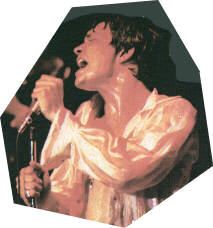
The Sanctuary packed in the crowds. And Grasso had us flyin' on a mix of Aretha Franklin, James Brown, Gladys Knight & the Pips, Booker T. & the MG's, laced with rock 'n' roll and ethno tracks,
Mitch Ryder, "the gargantuan volcano"
Chicago Transit Authority, Santana, the relentless Mitch Ryder & the Detroit Wheels, Olitunji and the Drums of Passion....a smokin' version of Bob Dylan's I'll Be Your Baby Tonight by a gospel choir called The Brothers & Sisters, and a favorite of mine Little Sister's hypnotic "You're the One." I have to say it again, Francis Grasso was magnificent!
Same-sex dancing was legal now, and it looked like this was the direction gay night life was headed in.
Cherry Grove has also laid claim to being the birthplace of the American disco ambience. In 1969 a guy named Ted Drach leased the Cherry Grove Hotel, a large U-shaped, two-story clapboard structure, from Jimmy Merry. Jimmy had put in a pool sometime in the 60's and there was a modest-sized dance floor in the bar, plus a large adjoining dining room. Drach had no previous experience supposedly just money to lease the hotel, and the Sea Shack (Merry's small restaurant built on the dunes, overlooking the beach.) According to what is recounted in Esther Newton's history of Cherry Grove, Drach claimed that early in the summer of 1970 he was followed home one night by a guy and they tricked. The guy claimed to be an electronic genius. Drach was looking to revive the hotel as the main center of social life in the Grove. Free-style dancing, as opposed to partnered dancing and line dancing, was already popular in the city. Shazam! The anonymous genius trick took over the larger dining room area, covered everything in blinking Xmas lights as well as lights that pulsed to the music, installed speakers to kill with and a DJ booth: The American disco is born.
This may well have been nothing more than a tall story that was put over on Newton one with more than a little spite and malice in it as many people clearly recall Michael Fesco being the driving force behind the birth of the Ice Palace, as the place was called. And he was the manager there for four or five years. Gay men started walking down the beach from the neighboring Pines to dance, and that prompted the restaurant owners there to take notice. Later in the decade Michael Fesco created Flamingo in Manhattan, undoubtedly the premier club while it was open. The music at the Ice Palace was not yet disco per se, of course, but mainly up-tempo soul. However, the scene was set and it would all come together in time. Sort of like the stable waiting for Baby Jesus.
John Whyte's Blue Whale bar and restaurant was the center of Pines social life right at the end of the Sixties decade, and it had a popular "tea dance" with another dance session post-dinner. In 1970 the neighboring Sandpiper restaurant was shooing the dinner crowd out around 10 or 11 p.m. so the tables could be shoved out of the way and a dancing crowd take over. The Blue Whale became the Boatel, which still had its jam-packed Tea, but the evening action belonged to the Sandpiper. I went out there once in '73 with Ken and his new boyfriend and a couple of straight girls right after he'd sold out his interest in a PR partnership. The Sandpiper was packed, and sweltering there was no a/c, just the open windows. I don't remember whether the DJ was using tapes or putting 45's together (no 12" singles existed at this time,) and the only music I remember for sure is an Aretha Franklin song that the crowd was wild for.
Although the Grove's gay residents (which was almost all 300 houses with their several thousand summer residents) were pissed, Drach in order to stay on top of the Pines' competition financially began to advertise his place in the city, and in the neighboring straight communities on Fire Island. This brought in a huge influx of business for him, but almost swamped the community in many ways. I would imagine, however, that his move probably had the effect of introducing this concept of a dance environment to more straight people.
PICADILLY PUB: THE BEGINNING
In the beginning God may have said, "Let there be light," but on what was to be the new gay Upper West Side, it was Jenny Tobin who said, "Let there be the Picadilly Pub." (And, yes, it only had one "c.")
The neighborhood got a calculated taste of
a new style in
gay life when this bar opened in 1971 in a former laundromat, on the other side
of the avenue just a half a block
up Amsterdam from the Candlelight (which by now, I think, had dropped "Lounge"
from its name.) There was nothing special about the appearance of
the bar, the floor was still paved with its old fashion white eight-sided tiles
and the walls were simply rough plastered. A long bar had been installed along
the left-hand wall, where the machines had been, there were a few small,
out-of-place sconce type lighting fixtures with cutsie little shades and a
narrow shelf for customers to put their bottles on along all the available wall space.
(right) Picadilly Pub was beneath red flag & building on other corner is the rear of the Beacon Theater
The manager was a new face in the neighborhood, a young Puerto Rican, Nefty, with a dazzling smile, but all the charm of a rusty razor. He had very definite ideas about two things that were going to make the Picadilly a success: the music and the bartender's image. The Candlelight was an old bar which was gradually changing with the times; the Picadilly was a "new" bar not just in the sense that it had recently opened, but more importantly it was a new kind of place in the neighborhood.
I was living alone in a studio apartment on West 80th St. now, and this place became almost the only gay bar I went to...I loved it.
The juke box was a shrine to soul Marvin Gaye, the O'Jays, Gladys Knight and the Pips, etc., and funk - Kool and the Gang, ConFunkShun.... White artists were limited to up-tempo hits that could fit in with this basic sound, from the likes of Elton John (e.g. - Take Me to the Pilot) and Rare Earth. Judy Garland had one record on the box in the beginning, as I recall, and there were one or two by the R&B-toned Dinah Washington. However, over the next few years black singers like Lana Lee, Millie Jackson and the raw and mean, Yvonne Fair showed up Judy's record went to juke box limbo, the lower right hand corner of the selection menu, and then disappeared. (Barbara Streisand took her place, but with a different up-tempo type of music, of course.) The entire roster of great black groups and soloists was on the menu, plus music from the blaxploitation films of the era, Superfly and Shaft. The juke box was carefully managed: recordings showed up as soon as they were hot or sometimes just before and last season's favorites were eased off at a steady rate to make room for new music.
This was music that demanded bodily motion, and aside from the individual pleasure this brings, I have to think that Nefty understood on some level that it also created a kind of group experience in the bar. Unlike the assumed intentions that brought the customers together the desire to socialize, the hunt for sex, the music and the heightened volume at which it was played (compared to bars in the recent past) virtually compelled a physical reaction. And each person could literally see himself joined with the others who were (physically) moving with the spirit of the place it was almost a dance bar without dancing. It worked, though at a much more subdued level, with an effect similar to the music in a "sanctified" church. The result was a much different and higher energy environment than the Upper West Side bar-goer had been used to.

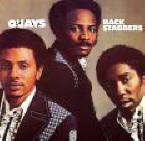

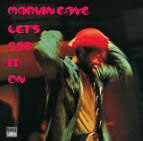
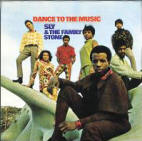
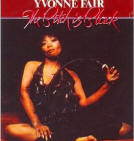
Gladys Knight & the Pips, O'Jays (Back Stabbers), Millie Jackson (Back to the Shit), Marvin Gaye (Let's Get It On), Sly & the Family Stone (Dance to the Music), Yvonne Fair (The Bitch is Black)
Behind the bar were Nefty and Nathan, both in what would later be described as "clone" attire flannel shirts, veeery tight Levis 501's and boots or work shoes. And in the case of Nathan, showing a basket so large that one customer claimed it must be "a sock full of dirty laundry." Both of them, at least in the early days of the bar, had to lean so close into their customers to hear an order and made such intense eye contact that they became something of a joke. Nothing in this act was like the crew over at the Candlelight, where the bartenders looked like what they were just nice neighborhood guys who came in to work a job.
 If the bartenders had a problem hearing the customers'
orders, the customers often had a problem hearing each other. There is a
temptation to say that the ability to "communicate" was inhibited by the volume
of the music and its constant rhythmic insistence. But, in fact, this wasn't the case at all: communication simply got guided into a very necessary intimacy. You were going to talk with your friends no matter what, even if
you had to talk right into their ears, so no
problem there. But meeting strangers and/or making contact with a
potential trick was actually being facilitated. The physical difficulty of
communicating easily in many parts of the bar
i.e. to just be fucking heard
meant
that the awkward social process of closing up the physical and psychological space
between you and the other guy had to be gotten over with almost
immediately.
If the bartenders had a problem hearing the customers'
orders, the customers often had a problem hearing each other. There is a
temptation to say that the ability to "communicate" was inhibited by the volume
of the music and its constant rhythmic insistence. But, in fact, this wasn't the case at all: communication simply got guided into a very necessary intimacy. You were going to talk with your friends no matter what, even if
you had to talk right into their ears, so no
problem there. But meeting strangers and/or making contact with a
potential trick was actually being facilitated. The physical difficulty of
communicating easily in many parts of the bar
i.e. to just be fucking heard
meant
that the awkward social process of closing up the physical and psychological space
between you and the other guy had to be gotten over with almost
immediately.
"The music's so fucking loud I can't hear you," said with a grin and a shake of your head, invited moving yourselves shoulder to shoulder and bringing your heads together - a business that could have taken half an hour to all evening in former bar environments.
And in the Picadilly the process of navigating from the front door over to the bar or down to the back of the room on a crowded night changed too. Instead of the awkward and pretty useless attempts to pass politely through a herd of guys with repeated "excuse me's" more appropriate to negotiating the aisle of a railway car full of commuters progress through the Picadilly was something on the order of traversing the length of a sexual sandwich, with a sometimes high incidence of harmless caresses and appreciative remarks along the way. But then the music was War's Slippin' Into Darkness or maybe the Staple Singers' I'll Take You There.
(Forget about getting a case of the vapors over being "molested" as would happen nowadays, if a guy didn't keep hands-off after you gently pushed it away a simple, "Fuck off" was the problem-solver.)
Soul and funk appealed to the feet and the pelvis, but there was an ironic something more. Their lyrics often had references to, and sometimes were very much about, discrimination and oppression of blacks by white America. And yet in the Picadilly (and other gay bars) this musical menu - with it's commentary on racial inequality - was being served up to a group of customers that was more white than black or Latino. I don't doubt that we white guys edited out bits and pieces of the lyrics that made us uncomfortable - similar to editing out the "she's" in old ballads - but much of the lyrical content was right on the dime as far as the situation of gay people was concerned. Of course you encountered anti-gay prejudice from blacks, e.g. in the Greek all-night coffee shop that had been next door to the Pic or in the Black Panthers' propaganda which equated gay men with "baby rapers". But the main force of homophobia that white gay people endured came from the white-dominated society, i.e. from other whites. It was whites who truly created and maintained the entire edifice of both legal and customary oppression of gay people. It was the white society which closed the doors to employment, education, public accommodation, housing, etc. to gay people. It was the power of the white man which brought discrimination against gay people into every sphere of life, it was the white man who set the law on gay people, it was the white man who created and promoted the humiliating stereotypes of gay people.
White gay men were not oblivious to these facts, and despite being white we enjoyed the barbs black music aimed at white power. What little room for resistance there had been for gay men in white culture had come from the role of comic sissy/fairy figures and to a lesser extent that of drag queen imitators of the man-destroying bitch; both of which at the end of the day confirmed straight stereotypes of the homosexual. I think gay men were drawn to black music and singers because we found in them what we would have liked to be but were not: until the 70's and 80's the rewards for passing, or even just masking our sexual orientation, were usually too great for many to risk the forthright bitterness, complaint and anger that blacks put out in their music.
Some gay people, usually those who were in their early twenties in this era, have memories of Glitter Rock - the New York Dolls, et al, but it was only something I read about, not something I listened to. And I don't recall my friends having any interest in the music, only in the outrageousness of that "scene" and it's gay associations (some a put-on.) As for rock in these years, much of it seemed fundamentally limp and irrelevant from a gay (or black) viewpoint, being rooted in the complaints of young straight, middle class whites. However, like most gay men I knew who bought records, I had a few favorite rock albums that stayed in my collection after most of my Sixties rock purchases had been dumped. At this point I remember four Beatles and Stones albums as being keepers - though I did hold onto a few others too; the Moody Blues and Pink Floyd were groups my friend Charlie and other guys had, and at the mid-point of the decade a new roommate was still very wrapped up in Emerson, Lake and Palmer. But youth-oriented Rock had cut off its roots in the original black rock 'n' roll, and in the early 70's was increasingly a white, male and macho thing.
Soul and funk was the gay menu of these year, and the Picadilly Pub got off to a roaring start because of it.
Rolling Stone reporter, Abe Peck, would write in
1976 that by the mid-Seventies "black style [was] more accessible to whites than
it was during the Smoldering Sixties." Indeed, but he is commenting
on the white mainstream playing
a belated game of catch-up to white gay men.
A SAFE GAY PUBLIC LIFE
The Mattachine Sip-in of 1966 probably had a more profound effect on the lives of gay men in NYC than any single event in the late Sixties. Gay bars were the principal meeting places for gay men not just for tricking, but for socializing. Their suppression by the Wagner administration in the first half of the Sixties decade had made meeting people and establishing friendships very difficult for new arrivals on the New York scene as I had found out. With the State Liquor Authority retreat after the Sip-in from its policy of prohibiting the serving of homosexuals, and the subsequent finding of the courts that this policy was not constitutional, the legalization of gay bars had occurred. Running a gay bar was no longer just a lucrative enterprise, it was a legal one. This did not mean that all the criminal interests disappeared from the field, but it did mean that they were now running in competition with anyone who could raise the cash and meet the licensing requirements...and steer clear of Mafia intimidation.
The gay population benefited in many ways most immediately in that the number of gay establishments serving alcohol began increasing rapidly. And as I recall, the managements and staffs were more consistently friendly, the surroundings were cleaner, the booze was unwatered and if the places smelled, it was usually from stale beer and not the stench of piss and shit from non-functioning plumbing. These changes were pleasant, the long term effects were potent.
Achieving public accommodation in a licensed bar was a major civil rights victory for gay people in the state. No longer was having a drink with your friends to risk public humiliation, harassment or arrest. After almost seven years of police action against gay life in the city, a sense of safety and with it the promise of an ongoing public social life came to the gay men and lesbians of New York.
The situation of gay people was further eased by the Knapp Commission investigation. In June 1970 Mayor Lindsay named a panel to began an investigation of corruption within police ranks as a result of spectacular revelations by a whistle-blowing patrolman (the famous Serpico) and a sergeant. The witness testimony before the Knapp Commission, as the panel was known, resulted in criminal indictments, and the commission's final report in December '72 found that corruption in the NYPD was widespread. No blockbuster surprises here for many gay New Yorkers. A new police commissioner and wide-scale reforms and disciplinary action reshaped the police force. This further ensured that gay bars and gay people would not be victimized by crooked cops.
While gay bars certainly functioned as places to pick up a trick, in many of them this was balanced by the steady patronage of customers for whom the bar was also a neighborhood meeting place. I met the overwhelming majority of my friends in gay bars, some on an individual basis and others because they were friends of people I had already met. And these were the people - and the places - that provided support which ran a gamut from pleasant companionship to help in time of serious problems. And my experience, I know, was shared by many others in the Seventies and Eighties.
The Lighthouse bar on Broadway in the 70's became the Westsider, an only briefly popular gay bar. Across Broadway on a side street the Bike Stop, a sharply decorated place, opened up. It stayed in business for many years, and had a loyal group of customers. It also got the reputation of being a haven for heavy drinkers and effeminate guys.
The Picadilly was reputed to be owned by the same couple, Sonny and Jenny, as the Candle rather strange, I thought at the time, to be in competition with yourself. In a year or two, Larry, one of their bartenders at the Candle became a bartender at the Pic, and in the mid-Seventies was the head bartender at the Westsider when it had a brief life but a rather good one as a gay cabaret called the Speakeasy. As it turned out, there was nothing "strange" about owning several gay bars in this part of the Upper West Side, rather an excellent sense of the neighborhood's prospects as it turned out. And once the gentrification process had clearly jumped 72nd Street, the rental and sale prices of properties in the West Seventies would rise at an ever-increasing rate, of course.
Wayland Flowers & Madame
 Bob
Manahan, my Junior college year NYC summer affair, appeared one night in July
'71 in the Candlelight, with his old buddy, Jimmy, still at this side. He
and Jimmy were living together down on 56th Street now - in my old extended
unemployment flop, the House of
Flowers! For awhile he hung out in the neighborhood bars, and he may have
been the one who nicknamed them the "Pig Circuit," as a back-handed reference to
the old Bird Circuit - and a comment on their customers as well, I suppose.
Though Bob was as working class as could be, when it came to gay life he flung
caustic snobbery on the winds as if he were privy to a secret manual of gay
pedigrees
the equivalent of Burke's Peerage. In August he invited a few of us
down to their one-bedroom apartment in the House of Flowers. One of the guests
was another Upper West Sider, Wayland Flowers the puppeteer, who had brought along his famous character
creation, "Madame," and they put on an impromptu show.
Bob
Manahan, my Junior college year NYC summer affair, appeared one night in July
'71 in the Candlelight, with his old buddy, Jimmy, still at this side. He
and Jimmy were living together down on 56th Street now - in my old extended
unemployment flop, the House of
Flowers! For awhile he hung out in the neighborhood bars, and he may have
been the one who nicknamed them the "Pig Circuit," as a back-handed reference to
the old Bird Circuit - and a comment on their customers as well, I suppose.
Though Bob was as working class as could be, when it came to gay life he flung
caustic snobbery on the winds as if he were privy to a secret manual of gay
pedigrees
the equivalent of Burke's Peerage. In August he invited a few of us
down to their one-bedroom apartment in the House of Flowers. One of the guests
was another Upper West Sider, Wayland Flowers the puppeteer, who had brought along his famous character
creation, "Madame," and they put on an impromptu show.
Although Nefty disappeared from behind the bar of the Picadilly after awhile, the early replacements were cast in the original mold. One slender, sinewy guy got the nickname "Knife" because of his sinister sharp-featured face and deep-set eyes. But going on their third year the bartender image lightened up, and at one point Maggie Jiggs arrived on the scene. Maggie had been tending bar at the Stonewall the night of the famous raid in June '69, and was reputed to "have a following," i.e. was popular enough to attract customers from previous jobs. Well, forget it! None of the Pic's customers gave a shit about who Maggie Jiggs thought she used to be, and the pigeons must have eaten the trail of bread crumbs, because her "following" never appeared. Perhaps Maggie had expected the customers to roll out the red carpet, but whatever the problem was, he was sour-faced and sullen behind the bar. He was also notoriously light-fingered. When Larry was in the bar and Maggie rang up the cash register, Larry would often chant loudly, "One for Maggie, one for the bar. One for Maggie, one for the bar."
Maggie disappeared almost as fast as the proverbial snowball in Hell.
Both bars were beginning to change. When I stopped in at the Candlelight now I didn't recognize a lot of the crowd, and it also seemed that the Pic was getting a somewhat larger clientele of Hispanic guys, and a few more blacks as well. But, as in the Candlelight, the customers intermingled socially and sexually. There was, however, a small number of Hispanic guys who clustered at the end of the bar near the front door of the Pic, and I came to realize that some of them had a bit of difficulty speaking English. This was not something I'd ever noticed across the street. On the other hand, these same guys did talk and trick with non-Hispanic guys, so I think they probably hung together essentially so they could speak Spanish. However, there also continued to be white customers with blue collar or low-paying jobs in the crowd.
The mix of people did not change markedly until about '74 perhaps. While groups of friends met there the same way they had at the Candlelight, there was more cruising and picking up going on, probably due to the larger crowd and the influx of new guys into the neighborhood.
Socializing with the straight employees from my job at Fairfield Reading had been something of an eye-opener. While they were a mixture of white middle class, and to a lesser extent working class, college grads from around the country. As a group they were decidedly liberal to radical in their professed social and political views. However, I discovered that my straight fellow workers, despite living in Manhattan for the most part, had acquired no non-white or blue collar friends that I ever met, and the hangouts I went to with them appeared to be gathering places for white middle class young people. This was a very strong contrast to the occupational/social class/ethnic and racial mixture which I was experiencing in the gay life on the Upper West Side (and what I saw the Village, as well.) It would not be until later in the Seventies that I would work with any straight white people and find they had casual, unselfconscious friendships with blacks and Hispanics.
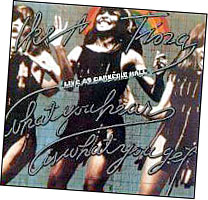 The
same year as the Picadilly opened, the Ike and Tina Turner Review did a sellout
concert of their standard raw, upbeat rhythm and blues music in a decaying old
Rococo movie palace, the Beacon Theater, on Broadway just around the corner
from the Candle and the Pic.
The
same year as the Picadilly opened, the Ike and Tina Turner Review did a sellout
concert of their standard raw, upbeat rhythm and blues music in a decaying old
Rococo movie palace, the Beacon Theater, on Broadway just around the corner
from the Candle and the Pic.
"We never, ever do nothin' nice and easy - we always do it nice and rough!"
Tina Turner was beyond terrific and in an era when stage show pyrotechnics were almost unheard of she disappeared at the finale in relentlessly pulsating strobe lights, an explosion and a puff of smoke! Later in the year they were to do a slightly slicker, but a much more sexually provocative version of this concert at Carnegie Hall. In 1969 a funky "swamp rock" band called Creedence Clearwater Revival had had a hit with a song called "Proud Mary." In 1971 Tina Turner did her version of it, and her extended maximum power songblast backed up by the vibrating, non-stop pelvis-pumping Ikettes became the Proud Mary if you were a gay man. The Ike and Tina Turner Revue was the soul and energy incarnate of the black juggernaut which totally ousted acid-, folk-, etc.- rock from the gay scene.
Also
in the neighborhood, in the basement of the venerable old Ansonia, were the
Continental Baths. While the "rooms" upstairs, cubicles would be more precise,
were the same old iron cot with paper thin mattress, the rest of the place was
more than a little splendid when compared to the grubby Everard or
the old Saint
Marks baths. Downstairs was a steam room and a sauna, of course, but also a
large pool, a dance floor, a lounge - and most famously a
cabaret, where the gay audience sat around wearing towels only. I went
there in the late 60's, and I
remember seeing Bette Midler and Barry Manilow which would have been 1970.
But I didn't go frequently, and I'm
not sure I went at all after '72. A bit later when had she become well known she delighted
talk show hosts by being very straight-forward about the fact that she
got her start at "the tubs." I saw, or at least glimpsed other
performers, but show time was not my reason for being there.
La Lupe
A 1973 issue of After Dark magazine has an ad for the Continental Baths in it listing previous performers who have appeared at the cabaret: Bette Midler, Barry Manilow, Labelle, Larry Kert, Freyda Payne, Vivian Blaine, Lillian Roth, Liz Torres, Peter Allen, LaLupe the wildly emotive Cuban singer, Eleanor Steber a former opera great who sang for a "black towel" event, and Dawn Hampton, who was approaching the peak of her cabaret career.
However, I stopped going to the Continental specifically because of the shows. They began to attract straights looking for a new trendy "kick," and for my money they and the shows got in the way of why I paid to go there. The whole show shtick dominated the place. I was not alone in my dissatisfaction, and the increasing annoyance that gay patrons felt reached a point where they abandoned the place wholesale and over a very short time span. It later became a club for straight swingers, Plato's Retreat.
 The
music at the Pic was so good that it begged to be danced to or something. We
used to hang around the juke box at the back of the bar, and sometimes someone
would snap a popper and surreptitiously pass it among us. This was a no-no in
the bar. Even if the distinctive odor hadn't penetrated the smell of beer and
cigarette smoke, in fifteen seconds the fact that four or five guys were
standing around undulating to the music like they were at a Motown audition was a dead give-away. By and large we got away with it, but sometimes Larry the
bartender, who was a friend, would yell out, "Alright, tone it down back there!"
or with less good humor, "Knock it off, guys!" Over-the-counter sale of amyl
nitrite had been banned in 1969, but they were still available a
The
music at the Pic was so good that it begged to be danced to or something. We
used to hang around the juke box at the back of the bar, and sometimes someone
would snap a popper and surreptitiously pass it among us. This was a no-no in
the bar. Even if the distinctive odor hadn't penetrated the smell of beer and
cigarette smoke, in fifteen seconds the fact that four or five guys were
standing around undulating to the music like they were at a Motown audition was a dead give-away. By and large we got away with it, but sometimes Larry the
bartender, who was a friend, would yell out, "Alright, tone it down back there!"
or with less good humor, "Knock it off, guys!" Over-the-counter sale of amyl
nitrite had been banned in 1969, but they were still available a![]() s black market
items for a couple of years after. However, the government, as I understood,
then clamped down on their manufacture and distribution knowing
s black market
items for a couple of years after. However, the government, as I understood,
then clamped down on their manufacture and distribution knowing
 full well that
they had been replaced for the most part in medical settings with tablets.
This may have been prompted in part by the fact that a few doctors would give
you a prescription for them for amyl nitrate vaporoles , or even sell to patients directly.
full well that
they had been replaced for the most part in medical settings with tablets.
This may have been prompted in part by the fact that a few doctors would give
you a prescription for them for amyl nitrate vaporoles , or even sell to patients directly.
A brand of head shop stuff. and a bottle of dealer's brew.
At this point the underground manufacture of poppers and their sale by dealers, began in earnest, and eventually the sale of a butyl nitrite substitute as brand name stuff in "head shops" and sex shops became common, with the bottles indicating that it was a room deodorant!!! or "head cleaner." However, the underground brew was usually far better. The upshot of this was that it became easier, and less smelly, to pass a bottle around than a crushed capsule.
Smoking grass in the Pic, or any bar, in the early Seventies would have gotten your ass lofted through the air and bonded to the sidewalk out front. But guys would go out and toke on a joint as they walked around the block it was late night in a quiet neighborhood, so the risk was slight. Before too much time had passed some guys simply stood in the doorway by the parking garage next door to smoke. But it certainly didn't please the Picadilly bartenders to have their customers blowing grass practically in its entrance.
The joint went around until the roach was too small to hold, even in a clip...then you opened the door and floated back into the bar, where the music of hits by Holland-Dozier-Holland and the other great black songwriters lifted you up and kept you up through the night Marvin Gaye - What's Goin' On, The Chi-Lites - Have You Seen Her and Oh Girl, Staple Singers - Respect Yourself and I'll Take You There, Laura Lee - Rip Off, Spinners - I'll Be Around, Betty Wright - Clean-Up Woman, Bill Withers - Lean On Me, Al Green - Let's Stay Together, Lamont Dozier - Take Off Your Makeup, O'Jays - Love Train, Gladys Knight and the Pips - Midnight Train to Georgia, Eddie Kendricks - Keep On Truckin', Earth, Wind & Fire - Mighty, Mighty...BT Express, Ohio Players, Three Degrees, Harold Melvin and the Blue Notes, War.....and even Barbara Streisand singing Jubilation.
By the late 60's and early 70's hallucinogenic drugs had became popular with many younger gay men, and a few guys in my crowd used acid every weekend it seemed. Various names floated around for types of LSD Sunshine, Purple Haze, "blotter"...etc. I still had an aversion to the idea of hallucinating, and didn't try it out.
POLITICS: YOU LOSE SOME AND YOU LOSE SOME
In the spring of 1971 the first gay rights bill was introduced into the New York City Council, but even though it had the backing of Mayor John Lindsay it failed to pass. It would fail to pass on the order of ten times over the next fourteen years. The strongest opposition was from Orthodox Jews and the RC Church, and it was city councilmen representing working class areas in the outer boroughs of the city who were its fiercest opponents in the council.
GLF folded shortly after GAA got underway. GAA, with its one-issue approach to gay rights and a formal structure, turned out to be a more stable organization. The group rented an old fire house in Spring 1971 from the City for a meeting place. It was located in SoHo, a district south of central Greenwich Village and north of Little Italy and Chinatown. (SoHo is a contraction for the phrase "south of Houston (street).) At this time SoHo was an area of grungy commercial buildings, with a thin population of residents, many Italian-Americans, and a trickling influx of artists. In the closing decades of the 20th century SoHo became the center of artistic life in NYC, and was filled with trendy restaurants and extravagantly expensive art galleries. Once cheap lofts were rehabilitated into residential living spaces selling for hundreds and hundreds of thousands of dollars, and in some cases millions. However, back in the 70's it was a quieter, somewhat rundown area and empty at night.
For
a few years GAA engaged in a barrage of publicity zaps, including sit-ins at
Harper's magazine and on the George Washington Bridge. After I moved to
West 80th I went with a friend to two or three general meetings of
GAA at the firehouse. This would have been in the winter of 1972 or early '73,
perhaps. I have only a few random recollections from these occasions.
One being that the
meetings were conducted (at least in part) by a guy dressed in leather from head
to toe, who - unfortunately - failed to deliver some no-shit mastery that was
sadly needed.
The meetings were interminable, the agendas grandiose, and
GAA seemed to have an endless, endless number of committees each populated by
pretty much the same names. The lesbians in attendance, I noticed,
spent most of the time chatting and were largely uninterested, except for
occasional
vociferously disruptive outbursts. Nothing I
heard or saw up close and personal moved me to join.
agendas grandiose, and
GAA seemed to have an endless, endless number of committees each populated by
pretty much the same names. The lesbians in attendance, I noticed,
spent most of the time chatting and were largely uninterested, except for
occasional
vociferously disruptive outbursts. Nothing I
heard or saw up close and personal moved me to join.
(right) GAA flag at the firehouse
GAA used to have weekend dances at the Firehouse and these were quite popular for awhile, the firehouse was a good space for this. Some guys from the neighborhood went down a few times. But it was an inconvenient place to get to by public transportation from the Upper West Side, and far easier to simply hop on the IRT at West 72nd Street and get off at Sheridan Square in the West Village.
While many guys went to the GAA dances, the organization had difficulty attracting people to join in its political activities. (Witness myself.) It remained a small group - less than 200, I have read - and eventually even its dances began losing out to the burgeoning West Village gay life. Then too, GAA made a miscalculation in its stance towards Mayor John Lindsay. Several times, both at official events and private social ones with his wife, they confronted and interrupted Lindsay in public. This did not sit well with many gay men. Lindsay was regarded very positively for having been the first public official in New York City to attempt to reverse the traditional homophobic policies of the city. Such a thing was nothing short of incredible for these years. He also backed the gay rights initiative in the City Council. The fact that "Handsome John" Lindsay also so clearly loved the city, and enjoyed going to Broadway shows, the opera and the philharmonic undoubtedly made him even more appealing to those gay men for whom these things were an important part of their lives too. And it seemed, as well, with the Reform Democrats having won the day, that gay people, especially in the Village where there was a very large concentration of them, would find a place in the regular political scene.
In the fall of 1974 the GAA Firehouse was destroyed by arson. Maybe its proximity to the heart of Little Italy was less safe than it had seemed, but the appeal of the GAA had already faded. Sixties style politics were almost defunct.
THE "RED MAYOR" BITES THE DUST
Mayor John Lindsay, nevertheless, was not doing well on the whole. His first term in '66 had begun immediately with a strike by subway workers during a cold January, and he was plagued by strikes of other municipal employees which crippled services sanitation workers, teachers. In his bid for a second term he had to run as the candidate of the Liberal Party, as the Republican party selected, Marchi, an arch-conservative for their ticket - an early harbinger of where the GOP was headed. Lindsay won not only because he was solidly supported by blacks, but also because his two opponents, both Italian-Americans, split those voters who detested him. He undoubtedly must have received the vast majority of gay votes as well, but in these years no one paid attention to what gay voters did.
Lindsay's second term was perhaps more ill-starred
than his
first . His advocacy of causes and policies on behalf of blacks and Hispanics
made him unpopular not only with working class whites, but middle class whites
and other politicians as well. His attempts to clean up the lower levels of
government and the police force made him even more unpopular when a two-year
investigation brought widespread corruption to light.
. His advocacy of causes and policies on behalf of blacks and Hispanics
made him unpopular not only with working class whites, but middle class whites
and other politicians as well. His attempts to clean up the lower levels of
government and the police force made him even more unpopular when a two-year
investigation brought widespread corruption to light.
1970's Upper West Side - when
the IRT had graffiti
and gangs of tough guys with cojones ruled the night.
(from imgur.com)
He was reviled for his liberalism, and branded the "Red Mayor." The cleanup operations after catastrophic blizzards, soaring oil prices and a doubling in the welfare rolls; combined with the costly packages to settle labor disputes - added to the past debt his administration had inherited were a recipe for fiscal disaster. When his second term ended at the end of 1973, no one gave a damn that he had made the city into a center of national and international tourism again and a magnet for arts and entertainment, nor that he had made Central Park safe and lovely again and a venue for free concerts. Or that he had also replaced the old weak lighting on thousands of miles of city streets with new high intensity lights which increased public safety. But he got the old New York treatment: Trow da bum oudda heah!
Ironically, Lindsay and his GAA nemesis went into the political dumpster almost simultaneously.
REFORM DEMOCRATS: BAD FOR THE "ETHNICS", GOOD FOR THE GAYS
The ascendancy of the Reform Democrats had pushed the working class, Tammany-loyal party members into the background, intensifying the anger they felt over the direction of the national Democratic party. At the same time the liberal Reform Democrats seemed to be creating an environment in which gay voters might find a place. The two Lindsay administrations served to underline for working class NYC voters that liberalism was their worst nightmare come true, and by repudiating Lindsay for an ultra-conservative Marchi the Republicans had recognized that fact. In the non-PC jargon of those years was emphatically: "No to niggers, no to Spicks, no to fags!!!"
For gays, who might have considered looking to the liberal wing of the Republican party yes, it did have one back then! Lindsay's departure was another symptom that this part of the party was on its death bed.
This was about the time that I changed my own party affiliation from Liberal to Democrat.
From a gay point of view the marginalizing of working class Democrats (often referred to now as "ethnics") was a plus, as they were usually conservative on social issues and more particularly, inclined to be very homophobic on the whole. However, I was aware, as were some of my friends and acquaintances, of conflicting feelings about this. We knew first hand about that hostility from our own personal backgrounds and usually had been delighted to escape for this reason; nevertheless, there were also happy memories and a nostalgia about our ethnic/working class origins. Our animosities toward aspects of our family and class backgrounds were specific, and while we wouldn't have wanted to "go back," so to speak many of us still had strong positive feelings about our origins too. However, gay guys from other socio-economic or religious backgrounds tended to see the "ethnics" (usually limited to traditionally Catholic groups) simply as evil bigots. Period.
In the latter half of the Seventies, when the makeup of the neighborhood had changed considerably, as had that of my group of friends, this contrast became more apparent. The "tone" of my social life worked in two modes. It had one quality when it included primarily people of WASP and Jewish backgrounds, and quite another when I was only, or mostly, with guys from working class Catholic backgrounds. This was something that worked in a casual, automatic way; and it was not until three guys, two from Protestant backgrounds and one a Jew - and they were not mutual friends pointed it out several times that I gave it much thought. One of them, John, who had been a psychologist by profession for a few years, was so observant about it that I tried to write it down later. "You guys [he was talking about four to half a dozen guys) talk in short hand sometimes when you're with everyone else....You have your own conversation going on, like in code, while you're talking with the rest of the room....I'm never sure whether you're doing it on purpose or not." Ah yes, in some respects this was like a more benign reflection of the bifurcation of gay life I had discovered back in Syracuse University. But whereas in Syracuse the campus guys and the city guys were almost unable to mix, in New York (and certainly in my life) there was a melding even if the differences were still there.
[I think that in the post-AIDS queer world European ethnic identification plays little or no positive part, and I wonder if pop culture and political correctness hasn't eroded the appearance though not necessarily the substance of social class differences as well.]
AND THE DEMOCRATS SHOOT THEMSELVES IN THE HEAD WHILE AIMING AT THEIR FOOT
In 1968, after the shambles that was the Democratic
convention, Richard Nixon had won the U.S. presidency. He implemented a
strategy of "Vietnamization" to end U.S. participation in the war.
The
main burden of combat would be returned to South Vietnamese troops allowing a
reduction in the number of U.S. troops, and thereby lessen domestic opposition
to the war in the U.S. all to be accomplished without undermining the efforts
of
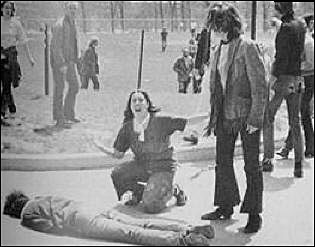 the Vietnamese to defend their country.
It could not be that simple, of course, and it seemed as if everything just unraveled
the massacre of Vietnamese women, children and old
people by U.S. troops was uncovered, Cambodia was invaded by the U.S. and became
totally destabilized, the Cambodian invasion caused a surge of protests and at
Kent State University and Jackson State National Guard troops and police shot
students to death.
the Vietnamese to defend their country.
It could not be that simple, of course, and it seemed as if everything just unraveled
the massacre of Vietnamese women, children and old
people by U.S. troops was uncovered, Cambodia was invaded by the U.S. and became
totally destabilized, the Cambodian invasion caused a surge of protests and at
Kent State University and Jackson State National Guard troops and police shot
students to death.
Kent State massacre by National Guard troops.
Vietnamese troops invaded Laos spreading the war to there, Australia and New Zealand withdrew their troops...and perhaps to quell dissent, large numbers of American troops were repatriated even as this went on. (One other result of the spreading destabilization of SE Asia was that the export of heroin and opium from the infamous "Golden Triangle" flooded not only Vietnam and the U.S. army with drugs, but sent waves of it for the first time into Europe and the U.S. for street sales.)
On the second night of the shambolic 1968 Democratic convention, the delegates voted for a commission which would seek to ensure that "all Democratic voters have had full and timely opportunity to participate." By early 1969, this appropriate and modest goal would be abandoned. For a variety of motives, largely having to do with bitterness over Vietnam and the Chicago convention mess, party reformers mostly associated with peace candidate, Sen. Eugene McCarthy abused the commission's mandate. Instead of following the mandate to reform the Democratic Party machinery, they set about to reinvent the party itself.
The new Democratic National Committee chairman Senator Fred Harris of Oklahoma didn't appoint any party hierarchs or persons representing their views to the commission, as had been promised. "I made up the membership of the commission in such a way as to ensure that [the commission] would come up with what they did come up with." Therefore the commission was stacked with party reformers, many of whom were deeply opposed to the war. The commission became a "fix."
It was headed first by Senator McGovern, from whom it receives its name.
And perhaps not just by chance, McGovern himself won the 1972 party
nomination, looking like a made-to-measure candidate of the
reformers. The twenty-eight-member panel became the means by
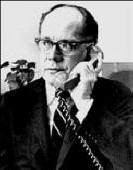 which antiwar liberals revolutionized the Democratic Party.
which antiwar liberals revolutionized the Democratic Party.
(right) Fred Dutton
Fred Dutton, manager of Bobby Kennedy's '68 campaign and author of the minority peace plank at that year's convention, emerged as the architect of this feat. His goal involved putting an end to the New Deal coalition of Franklin Roosevelt, the electoral alliance which had supported the party from the early 30's around a broad working-class agenda. In its place, Dutton sought to build a loose peace constituency, a collection of groups opposed to the Vietnam War and more generally the military-industrial complex.
Although both Dutton and Kennedy had included blacks in their alliance in his '68 campaign, Kennedy himself looked to blue-collar whites and white ethnics too for his main support a continuation of the New Deal model. But the new coalition was modeled on the one created by Eugene McCarthy, whose support was primarily among the young and college-educated. To this end, Dutton decided that Democrats would need to appeal to three new constituencies young people, college-educated suburbanites, and feminists, while ceasing to woo two old ones Catholics and working-class whites. The Democratic party coalition of FDR was smashed, and its base virtually shown the door and ushered into the waiting arms of the GOP.
He used one proposal to engineer the emerging feminist movement into the Democratic party, and other measures to, in effect, help secular, educated elites wrest the party machinery from state and big-city bosses. The 1972 convention was significant in that the new rules put into place as a result of the McGovern commission also opened the door for quotas mandating that certain percentages of delegates be women or members of minority groups. In 1968, for example, 13 percent of the delegates to the Democratic convention were women, but in 1972, that number increased to 40 percent. And although these groups did support the antiwar position of the reformers, they expected support for their own specific interests. Discussions on abortion and gay rights entered the convention arena, which had the effect of loosening other groups' ties to the party. Some of the results led to bizarre anomalies, one Midwestern agricultural state had a delegation abundant in women and representatives from higher education, but lacking farmers, the New York State delegation reputedly had nine gay people, but had no representatives from organized labor.
The 1972 convention delegates of Dutton's new party were less representative of the party rank and file, and the American mainstream, than any delegations seated in the past! George McGovern remarked ruefully later, "I opened up the doors of the Democratic Party, and 20 million people walked out."
This led to a class shift in each party, as affluent liberals gained more power in the Democratic party, working class people moved to the Republicans. As a result, the now familiar spectacle emerged. The GOP distracted its rank and file with a non-stop Punch and Judy show promoting a Christian America of gun-toting citizens parading in the regalia and ritual of High Church Patriotism, while its professional politicians continued to keep a lid on taxes for high earners and went to bed with industry and big business. The Dems had worked hard to reinvent themselves, but in the coming years they were routinely putting on declamatory exhibitions of pious outrage for their African-Americans, feminist and gay and lesbian regulars, as the party elite of white, well-educated professionals were happily waltzing with Wall Street and the banking industry, interests not exactly favorable to their new party regulars. And by the 1990's the real power in the United States had passed into the hands of its corporate entities.
The McGovern commission's machinations helped create the modern presidential primary system. Perhaps most importantly, the commission changed the rationale for choosing presidential nominees: Picking a candidate who was likely to win became less important than choosing one who would attract voters in the primaries, and these lean more heavily toward socio-economic elites and special-interest groups than do voters in the actual presidential election.
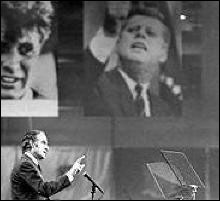 The
1972 convention was one of the most bizarre in American history, with sessions
beginning in the early evening and lasting until sunrise the next morning, and
outside political activists gaining influence at the expense of elected
officials and core Democratic constituencies.
The
1972 convention was one of the most bizarre in American history, with sessions
beginning in the early evening and lasting until sunrise the next morning, and
outside political activists gaining influence at the expense of elected
officials and core Democratic constituencies.
Say guys,
you sure anybody's out there?
McGovern giving his 3 a.m.
acceptance speech.
George McGovern ended up delivering his acceptance speech at 3 a.m. It was the second televised debacle in a row for the Democrats. I found the shenanigans close to unbelievable. There was no way these people could win an election.
Republicans unrelentingly pointed to Senator McGovern as a radical leftist. He was unable to shake that characterization, regardless of the very dubious course of "Vietnamization" Americans paid little attention to him. Two weeks before the election Secretary of State Kissinger announced that "peace was at hand".
Despite the very widespread disgust with the war, Americans were clearly fearful to elect a president who represented such narrow constituencies with extreme left-of-center goals. However, McGovern was undermined by forces which ordinarily would have supported a Democratic candidate: mainstream Democratic regulars failed to embrace the party candidate; AFL-CIO president George Meany, an old school anti-communist, guided organized labor's desertion because he opposed McGovern's anti-Vietnam War position; and Jews feared that he was not pro-Israel enough. The result was one of the most lopsided elections in American history. McGovern was absolutely skunked he carried only Massachusetts and the District of Columbia, and his share of the popular vote was so puny that he received only 17 electoral votes to President Nixon's 520. The anti-war movement was numb: President Lyndon Johnson had bowed down before it, and the Democratic party had consecrated itself to it but Tricky Dick Nixon wiped his butt on it and came up a winner! As president, Nixon continued to play out the war according to his own agenda, and in a manner that strengthened and coalesced American patriotic sentiment so that while it was not blindly pro-war, it was thoroughly anti anti-war. When Nixon was ready, he simply abandoned the South Vietnamese.
Two major blows to the Democratic Left were that it disappointed blacks of the inner city, and it proved equally unable to foster self-confidence and security among whites with lower incomes. Too much was invested and far too much jettisoned in trying to turn the Democratic party into the "peace party." But its most grotesque blunder was that it allowed the Right to co-opt Patriotism. Student demonstrators were enchanted with burning the American flag as a protest. And in trying to embrace and lead anti-war sentiment without unequivocally disavowing flag burning the Democrats became associated with disloyalty. And that stigma has stuck. In the decades following these events the Democrats were unable to consistently attract and hold centrist voters, and steadily lost membership through a failure to identify and articulate long-term economic issues.
While the Democratic party became progressively weaker and disorganized from this point, gay people in New York City went on to make a place for themselves in it, and in city politics too, after these local and national events came to pass. And in what are now called "blue states" gay people have also become a presence in elective offices.
In my college years among the many assigned readings were A Generation of Vipers by Phillip Wylie, The Hidden Persuaders by Vance Packard and The Lonely Crowd by David Riesman. The social trends and changes explored in these three books, all written before 1958, were already demonstrably among the strongest forces in American culture and society in the Sixties. Then the Vietnam War fractured America like no other event since the Civil War, and in the fall-out the old Democratic party was gutted while the Republicans reaped rich rewards by cultivating extreme social and religious conservatives. By the mid-Seventies all the forces, which have shaped the United States as it exists in the 21st century, were in place and potently active.
In 1974 New York City congressional representatives Ed Koch and Bella Abzug introduced a measure in the House which would have protected gay men and lesbians in the workplace. It did not succeed, but the battle for gay equality had been joined on the national stage. By the end of the century, legislation guaranteeing gay people equal opportunity in employment and housing still existed in only one-third of U.S. states; nevertheless, gay political energies and money were redirected. First, to the grossly miscalculated attempted reform of the armed services policy toward gay people in the early 90's, which resulted in the implementation of a new policy under which more people were discharged for their sexual orientation than under the old system. (The new Don't Ask/Don't Tell policy was rescinded in 2011 almost two decades after its enactment.) Second, gay rights activity then focused on same-sex unions, but the goal of legal same-sex unions was soon abandoned for that of same-sex marriage. The, by then, enormous power of conservatives and Far Rightists retaliated with the anti-gay Defense of Marriage Act which became Federal law in 1996. By 2010 seven states unequivocally allowed and recognized same-sex unions; however, the Rightist backlash was far stronger by that same year 29 states had amendments in their constitutions which restricted marriage to one man and one woman, while 12 others had enacted laws restricting marriage on the same basis. However, the U.S. Supreme Court in 2015 did come down on the side of same-sex marriages.
The Democratic Party in the more than four and a half decades following the McGovern Commission coup became an ever-increasingly smug, self-righteous political creature, one dangerously out of touch with too many white Americans. This would culminate in the catastrophic defeat of 2016 which stretched from the White House through both houses of Congress to the majority of state governments.
GAY KULCHA - HIGH AND LOW
While I was living in the House of Flowers I began putting things I thought I shouldn't throw out, or things I didn't want to throw out into an empty stationary box a "trick book" I kept that year, unemployment books, invitations, letters, clippings and over the years, I would periodically go through these odd bits, sentencing some to the waste basket and supplying a sturdier, and usually larger storage box for the remainder.
For almost thirty years two magazine
articles published a few months apart in the beginning of the 70's part of this
cache.
Both were personal essays, the first appeared in the September 1970 Harper's Magazine. I
didn't read the magazine regularly and was unaware of it until the wave of anger
and fear that it provoked reached me a few weeks after it came out. Someone
gave me his copy, and I read "Homo/Hetero: the Struggle for Sexual
 Identity" by
Joseph Epstein. (He was a dapper academic who went on to be editor of The
American Scholar for many years, a "cultural critic" and a mediocre fiction
writer.)
Identity" by
Joseph Epstein. (He was a dapper academic who went on to be editor of The
American Scholar for many years, a "cultural critic" and a mediocre fiction
writer.)
Joe Epstein, wishing gays away.
In his jeremiad Epstein began with "hedonism," but then settled in on homosexuals who had been "cursed....with evil luck," which he characterized as a state of "permanent niggerdom." (Yowsa, boss!) Nowhere, that I recall, did he recognize seething homophobia such as his own as causative.
He did, however, have a solution an startlingly final one for a Jew had he the power he would "wish homosexuality off the face of the earth." How one would do that without wishing homosexuals off it as well, he did not explain. Reichsfόhrer Hitler had had the same aspirations for a Jew-free utopia, and he left working out the nasty details to others too; so perhaps it is unkind to fault Mr. Epstein on the details of his wishing away. Midge Decter, the magazine's managing editor, although a Jew, failed to see that similarity and was stoutly behind the Epstein article; not surprisingly she would author an equally poisonous one in 1980, "The Boys on the Beach." It was Gore Vidal who pointed out the parallel for their benefit. GAA pulled off a sit-in type protest at Harper's with considerable skill and humor; it lasted most of the business day and attracted TV coverage.
The other article I saved had appeared in the New York Times Magazine one Sunday in early January '71 as a direct result of Espstein's vilification. Merle Miller, a respected biographer of Presidents Truman and Lyndon Johnson, wrote a 7-page essay, "What It Means To Be a Homosexual." His was a thoughtful, unsensational response, and received a widespread positive reception. His most memorable comment: "...you cannot demand your rights, civil or otherwise, if you are unwilling to say what you are." Miller's Times essay probably got considerably more exposure than the Harper's piece.
In the Spring of '71 my friend Don P. and I went
to see Edward Albee's All Over at the Martin Beck Theater. Albee was an
openly gay playwright, though this play had no gay aspects. His star had
been rising since his early successes, Zoo Story, The Death of Bessie Smith,
The Sandbox and An American Dream in the late Fifties and early
Sixties, and Who's Afraid of Virginia Woolf (1962) had earned him a Tony.
American Dream in the late Fifties and early
Sixties, and Who's Afraid of Virginia Woolf (1962) had earned him a Tony.
Edward Albee, 1963 Showbill
All Over was a resounding thud, and some pundits declared that Albee was washed up. The next year we went to see his play Seascapes, which fared somewhat better. Contrary to those predictions, however, Albee continued to create interesting new work, and new productions of his older work have taken place around the U.S. and the world over the years. He has also been generous in sponsoring workshops for developing young writers.
 The
openness that had begun mainstream media and the arts in the Sixties increased,
and it included the subject of the lives of gay men and women. Movies and
television probably got the most exposure. I saw Midnight Cowboy ('70)
and Sunday, Bloody Sunday ('71), both of which received critical acclaim
and did well at the box office.
The
openness that had begun mainstream media and the arts in the Sixties increased,
and it included the subject of the lives of gay men and women. Movies and
television probably got the most exposure. I saw Midnight Cowboy ('70)
and Sunday, Bloody Sunday ('71), both of which received critical acclaim
and did well at the box office.
Loud family, Lance at back left
That hot air balloon masquerading as a sacred cow, the American family, took a couple of reality hits early on. Look magazine (the former rival to Life as a photo magazine) included a gay male couple in a 1971 issue on the American family. Gasp, no! The American family became something of a dark comedy with pratfalls in a nine-part PBS special in '73, An American Family. A nice suburban family, the Louds, literally fell apart during the course of the filming, and the ultimate zinger was when teenage son, Lance, came out to his family as gay. Quite a journey from the sit-com fantasies of the Fifties!

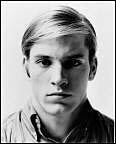 Paul Morrisey of Andy Warhol's in/famous "Factory" filmed the enigmatic and
voluptuous Joe Dallesandro in Heat in 1972, completing a trilogy of films
which began with Flesh and Trash. These helped make "Little Joe,"
the former nude physique model and prostitute, into a sleazy, sulky male sex
symbol in the underground film world with a huge following male and female.
Paul Morrisey of Andy Warhol's in/famous "Factory" filmed the enigmatic and
voluptuous Joe Dallesandro in Heat in 1972, completing a trilogy of films
which began with Flesh and Trash. These helped make "Little Joe,"
the former nude physique model and prostitute, into a sleazy, sulky male sex
symbol in the underground film world with a huge following male and female.
(right) Joe and the Sticky Fingers cover
After Dark was more delirious about him than ever. The Stones '71 Sticky Fingers album used a Warhol shot of Joe's basket on the cover, and in 1984 the Smiths used a still from Flesh as the cover of their debut album. The Sticky Fingers cover caused a furor and some stores refused to display it.
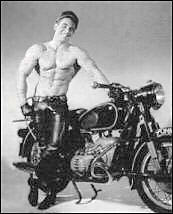 Fred
Halsted, S&M aficionado and XXX film actor, emerged as a director rivaling Kenneth Anger in the genre of gay
art-erotica. L.A. Plays Itself (1972) was his take on the same
territory as Anger's
Scorpio Rising. When it opened at the 55th Street Playhouse,
doubled billed with his Sex Garage, it was a case of see-it-now, or now
you don't. The police shut it down not for the notorious fisting
vignette that climaxes L.A. Plays Itself (which is cut from the video
versions that I have seen), but for a scene in which a guy gets it on with his motorcycle.
Fred
Halsted, S&M aficionado and XXX film actor, emerged as a director rivaling Kenneth Anger in the genre of gay
art-erotica. L.A. Plays Itself (1972) was his take on the same
territory as Anger's
Scorpio Rising. When it opened at the 55th Street Playhouse,
doubled billed with his Sex Garage, it was a case of see-it-now, or now
you don't. The police shut it down not for the notorious fisting
vignette that climaxes L.A. Plays Itself (which is cut from the video
versions that I have seen), but for a scene in which a guy gets it on with his motorcycle.
John Tristram, photo by Scott of London (aka Tom Nicoll)
In '75 Erotikus, a very well done and often quite funny history of gay porn films from the era of the posing strap to the mid-70's, featured Halstead as the hunky, ultra-cool narrator. He played his part from a director's chair, and as the movie progresses each time it cuts to Halstead he is wearing less clothing, until at the appropriate historical moment he flops a large erection out of his jeans. The film's most unforgettable scene is a clip of a blond young man on his knees in bed, straddling a dildo and not very successfully attempting to wiggle his way onto it as the Supremes sing Ain't Nothin' Like the Real Thing. Surely the funniest scene in 20th century film porn.
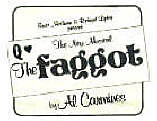 In
'73 The Faggot! by Al Carmines, the musical-writing minister at Judson
Memorial Church, got rave reviews from Clive Barnes the theater critic for the
New York Times and Vito Russo of Gay, among others and was still
selling out after its three-week run at Judson. It moved to the Truck and
Warehouse Theater (where I saw it with the usual group of suspects from the
neighborhood.) Bruce Mailman, later of St. Mark's Baths and Saint disco fame,
was a co-producer. I always enjoyed Carmine's sense of humor, but this was
truly special. There was even a commercial recording of this musical.
In
'73 The Faggot! by Al Carmines, the musical-writing minister at Judson
Memorial Church, got rave reviews from Clive Barnes the theater critic for the
New York Times and Vito Russo of Gay, among others and was still
selling out after its three-week run at Judson. It moved to the Truck and
Warehouse Theater (where I saw it with the usual group of suspects from the
neighborhood.) Bruce Mailman, later of St. Mark's Baths and Saint disco fame,
was a co-producer. I always enjoyed Carmine's sense of humor, but this was
truly special. There was even a commercial recording of this musical.
Carmines died in August 2005. In 2000 he wrote the following for a service celebrating Judson House, a historic building which had been used by the church as a health center, student housing, staff housing and other purposes. He wrote:
"In 1970 my apartment was renovated. I went to California, and after two months returned home to New York. I opened the door to my apartment, and it was like opening a door into space. The first thing that happened was that I fell. Bruce Mailman had built platforms, catwalks, all around the edge of the place, and I now had a sunken living room, which Bruce said was very chic. This huge, sunken space was surrounded by cubes that were covered with gray industrial carpeting. My grand piano was in this space. When I opened the door to the bathroom, there was a sunken tub. I was used to taking a bath in a regular tub. I was never good with my feetI was never a dancer. I fell into the tub every time I took a bath. I stopped taking baths because I could not get in and I could not get out."
In a more hoity-toity realm there was the New York City Opera's production of Catulli Carmina. The NYCO chorus and dancers had done an exciting production of Orff's Carmina Burana, so I was anxious to see this. In it Orff dramatized some poems of the Roman Catullus, whose work is highly charged with infidelities and seductions, both heterosexual and homosexual. The scenes between the two lead male dancers were smoldering, and at one point the brawnier one, dressed in black natch, seized the other around the waist and raised him up in a kind of bear hug against his chest...and then slowly the other dancer slid through his arms, and down his body until they were face to face, and the hunk in black opened his mouth and moved his face forward to kiss the other...who after too long a pause turned his face away. Damn! I didn't know they did things like that in ballet. And judging from the Ooooo's I heard from the audience, neither did quite a few other folks.
E.M. Forster died in 1970. Christopher Isherwood had been entrusted with Maurice, his long shelved novel about same-sex love written in 1913. Isherwood saw that it was published in 1971. Forster had dedicated the book to: "a happier year."
(below) Mishima with Noh theatre mask
 Because of my interest in Japanese literature,
which had
started back when I was working at the Times, I had read three of Yukio Mishima's books, two of
which Confessions of a Mask and Forbidden
Colors had strong gay themes. Mishima, who was bisexual, or
perhaps a married gay man, had killed
himself in 1970 after an abortive coup
attempt by his private militia. His final work, a tetralogy entitled The Sea
of Fertility began coming out in the U.S. in '72.
Because of my interest in Japanese literature,
which had
started back when I was working at the Times, I had read three of Yukio Mishima's books, two of
which Confessions of a Mask and Forbidden
Colors had strong gay themes. Mishima, who was bisexual, or
perhaps a married gay man, had killed
himself in 1970 after an abortive coup
attempt by his private militia. His final work, a tetralogy entitled The Sea
of Fertility began coming out in the U.S. in '72.
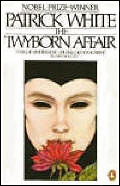 The
overall theme of the four volumes is the fading of the old Japan from the first
decade of the 20th century through the aftermath of World War II. The story
concerns two male high school classmates, one of whom is deeply infatuated with
the other. After the early death of his friend the grieving survivor discovers
him reborn three more times and obsessively spies on him through each new life.
The
overall theme of the four volumes is the fading of the old Japan from the first
decade of the 20th century through the aftermath of World War II. The story
concerns two male high school classmates, one of whom is deeply infatuated with
the other. After the early death of his friend the grieving survivor discovers
him reborn three more times and obsessively spies on him through each new life.
(right) 1981 edition with cover by Mel Odom
Patrick White, an openly gay Australian writer, won
the Nobel Prize for literature in 1973. I had been enthralled with one of his
books, Riders in the Chariot. At the end of the decade he wrote The
Twyborn Affair, a fascinating story about a sexually ambiguous man
who leads three different lives in the book's three sections: one in France, as
a woman before World War I, another in Australia, as a man, on a sheep station
and the third, in London as the madam of an exclusive brothel.
Mel Odom
The book cover on The Twyborn Affair (above right) was one of many created by Mel Odom, an Upper West Side artist. He had a highly individual style that conveyed a lush but steely, unsentimental eroticism. It was instantly recognizable. Judging from the number of covers I saw, his services were in wide demand.
(above) illustration for Blueboy
And I don't think I ever caught sight of an Odom illustration on a cover that I did not pick up the book to examine it. They were, in my experience, fascinating. His work was on books by Nobel prize winner, Patrick White, as well as those of Ruth Rendall, Edmund White (farther down on this page), and Ann Rice among others, and in publications as diverse as Blueboy and Omni.
Google "Mel Odom", then click "images for mel odom"
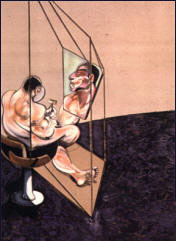 In April '75 Larry Clinton and I went to the Metropolitan Museum to see an
exhibition of works by the contemporary gay Anglo-Irish painter, Francis Bacon.
We lucked out either in the day we picked or the time of day, because there were
not many people there. I was awed
or maybe even a bit shocked, and I
think Larry must have had similar feelings, because for someone who was almost
never at a loss for a comment he was very subdued. After awhile we drifted
apart and moved through it separately.
In April '75 Larry Clinton and I went to the Metropolitan Museum to see an
exhibition of works by the contemporary gay Anglo-Irish painter, Francis Bacon.
We lucked out either in the day we picked or the time of day, because there were
not many people there. I was awed
or maybe even a bit shocked, and I
think Larry must have had similar feelings, because for someone who was almost
never at a loss for a comment he was very subdued. After awhile we drifted
apart and moved through it separately.
Bacon: Three Studies of Male Back
These paintings also had a very personal resonance. Early in the Seventies, not long after the Picadilly Pub opened, I met a guy there who I'd never seen in the bars before, Howard Barr. Our initial trick night developed into an intense sexual relationship which lasted about thirteen years. Howard had large eyes and a brooding almost stolid expression, and when I met him at the beginning of the 70's he had a worked-out, well-muscled body, though he said he was forty. Many of Bacon's nude males immediately reminded me of him. Our relationship began at a highly charged erotic level and quickly lost any romantic dimension; over the years that followed sexual intensity became our obsession. This mood was echoed in the atmosphere of Bacon's paintings with their contrast of almost empty interiors and the coiled, bursting body energy. Though Howard was the principal pianist for a ballet company, it is Bacon's paintings and not some piece of music that recalls him. Our carnal relationship was the most powerful one I ever experienced.
I wrote in a journal that I came away from the exhibition feeling like people must have centuries ago when they encountered the paintings of Michelangelo or Caravaggio for the first time. And the force of that impression hasn't diminished. But I don't remember that anyone ever wrote about Bacon for Christopher Street magazine, and that strikes me as odd now.
The relationship between Howard and I finally came to an quiet
and undramatic end in the first half of the Eighties. In 2014 I read
that he had died at an advanced age in New York City. His obituary gave a
detailed biography, including, of course, his birth date. I was shocked to
discover that while Howard had told me he was forty when we met and had an
impressively muscular body, he was in fact fifty years old at that time!
Howard had an incredibly busy career which brought him great renown in the
world of dance, but somehow he had obviously found time to put in a lot of hours
in the gym for many years as well. I still find it hard to believe, but
there it is in the papers.
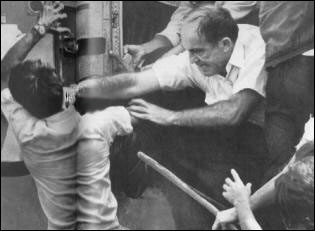

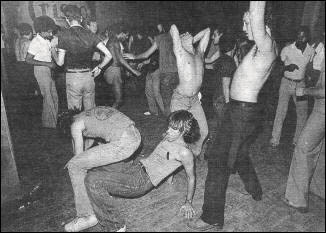
Americans desperately fleeing Vietnam '75 Polish Cabaret poster Crisco Disco dance floor
The film version of the Broadway musical Cabaret opened in 1972, and it scored a bit hit with gay men handsome Michael York as the bisexual male lead and Liza Minelli as Sally Bowles undoubtedly accounted for its first flush of popularity. (Minelli was great in the musical numbers, but a total turkey with the acting demands of the role miscast.) Very soon not a few men saw congruence between the era depicted in the movie and their own, for which references to Cabaret were sometimes a kind of shorthand.
Over the
next two years the national psyche was battered by the fall of Richard Nixon as
the result of the criminal activities of his inner circle and his cover-up
attempts, and then by the accelerating collapse of our Vietnam "withdrawal,"
which turned into a headlong retreat in early '75. Americans watched in shame
as thousands of panic-stricken South Vietnamese attempted to flee with the
departing Americans, and as most of them were abandoned even shoved and
punched from departing planes left to be punished as collaborators by the
triumphant North Vietnamese. These were surely some of the most wretched
pictures from the entire disaster. For many Americans this humiliation was
the fault of Leftists and liberals, irrevocably identified as traitors and
dangerous revolutionaries through their association with adolescent
flag-burners. Patriotism, as a consequence, became the exclusive property
of the country's more conservative citizens, and it has remained that way
ever since.
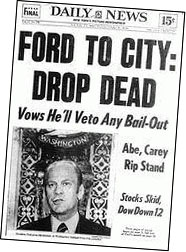
(right) October 30, 1975 New York gets the news
For New Yorkers there was a second bitter pill to swallow. Lindsay departed at the end of 1973. The vacuous Democratic candidate Abe Beame, who had been city Comptroller under Wagner and Lindsay was elected mayor. Some gay people held their breaths including me afraid that an old line Democrat in Gracie Mansion could mean an attempt to return to the bad ol' days of Mayor Wagner. Gay, shmay! Beame couldn't have cared less. And even if he had, he was in deep shit before he even started. New Yorkers found their city in financial chaos and the issuer of virtually worthless bonds bankruptcy seemed imminent.
Many people soured on politics. Both the idealism of the Martin Luther King, Jr. years and the hang loose doofiness of the Hippies were over the hill and the Vietnam war had turned into a humiliation as well as a heartbreak. A lot of people simply wanted to forget all of it, and just have a good time.
 They
were helped in this endeavor by the pharmacopia of drugs that had achieved
notoriety in the late Sixties. Marijuana/grass use had become established
across a wide spectrum of the American population, and drugs generally lumped
together as "hallucinogens" (LSD, psilocybin magic mushrooms, mescaline, STP,
etc.) were also in vogue. New York gay life did not stint on them. At the outset of
this era cocaine use was limited. One factor was the extreme cost, but just as
important, I think, the high you got from it was considerably different from
that experienced with either grass or hallucinogens. It certainly had not been
a drug compatible with the Hippie ethos, and it was not immediately compatible
with the spirit of the gay dance scene in the early Seventies. Heroin was no
longer a problem confined to racial minorities or urban ghettoes since the
Vietnam
war, but it made almost no headway into gay life compared with the
mainstream.
They
were helped in this endeavor by the pharmacopia of drugs that had achieved
notoriety in the late Sixties. Marijuana/grass use had become established
across a wide spectrum of the American population, and drugs generally lumped
together as "hallucinogens" (LSD, psilocybin magic mushrooms, mescaline, STP,
etc.) were also in vogue. New York gay life did not stint on them. At the outset of
this era cocaine use was limited. One factor was the extreme cost, but just as
important, I think, the high you got from it was considerably different from
that experienced with either grass or hallucinogens. It certainly had not been
a drug compatible with the Hippie ethos, and it was not immediately compatible
with the spirit of the gay dance scene in the early Seventies. Heroin was no
longer a problem confined to racial minorities or urban ghettoes since the
Vietnam
war, but it made almost no headway into gay life compared with the
mainstream.
"Ah, sweet misery of life
-- how you taste!

sweet-n'-sour piccalilli amply dumped on fudge ripple."
from diaries of gay poet James Schuyler
Since the late 50's the visible center of gay life had shifted from 8th Street and Washington Square to Christopher Street and Sheridan Square in the Seventies Boot and Saddles bar at Christopher and Seventh would be the gateway as gay bars and businesses and the traffic of gay life moved down Christopher, crossed Hudson and anchored itself at West Street and the river. I wasn't going down to the Village very often though, as the Upper West Side was increasingly satisfactory and affordable as a place to eat out and the bar scene was fine. However, in 1971 the following gay places were ones I went to in the Village Exile (an after-hours dance place on a couple of levels), Luigi II, One Potato and the Finale (restaurants); Zodiac and the Triangle (bars, and the latter had the first black man, Harley, I saw tending bar in a mostly white place) and there were other places open that I didn't go to.
The parking lots for large freight trucks in the vicinity of the International Stud bar were already open air sex picnics known across the city as "the trucks."
The
abandoned pier buildings on the waterfront were surreal sex palaces late at
night (see the opening chapter of Edmund White's Nocturnes for the King of Naples.)
Pier
48 was the setting where many musclemen were photographed for gay greeting cards
and post cards, e.g. Rock Shots. It burned down in the late winter of 1976.
There had been several muggings and knife attacks there and the grapevine said
some gay guys set fire to the place to get rid of it.
The pier at
 the end of
Christopher
Street was used as a place for sunbathing and just hanging out
and it was a
favorite spot of gay men. West Street eventually became lined with gay bars and
gay businesses, which led up past 12 West, the Mineshaft and the Anvil almost to Chelsea. On weekends the gay pedestrian traffic was so dense at the end
of Christopher Street and along West Street by the waterfront that it slowed
down the vehicle traffic to a snail's pace.
the end of
Christopher
Street was used as a place for sunbathing and just hanging out
and it was a
favorite spot of gay men. West Street eventually became lined with gay bars and
gay businesses, which led up past 12 West, the Mineshaft and the Anvil almost to Chelsea. On weekends the gay pedestrian traffic was so dense at the end
of Christopher Street and along West Street by the waterfront that it slowed
down the vehicle traffic to a snail's pace.
1983 cover by Mel Odom
Caffe Cino and the Judson Poets' Theater, both with strong gay associations and gay and gay-friendly works, had been in the center of the alternative theater movement, Off-Off Broadway. Charles Ludlum's high-camp 1973 version of Camille for his Ridiculous Theatre Company put him in this worthy company, and proved to me that drag and camp could be funny when they were unleashed into new territory. A decade later his play The Mystery of Irma Vep was cited as one of the best plays of 1984 by Time magazine and the New York Times. This brilliant comedy is a tour-de-force for two actors, who play eight roles (men, women and monsters) in a dizzying full-length quick-change act.
In 1974, Doric Wilson and other gay men formed TOSOS (The Other Side of Silence), as the first professional theatre company to deal openly and honestly with the gay experience. One of TOSOS' most interesting productions was of Wilson's play The West Street Gang done in the Spike bar in Chelsea.
Most gay people are probably aware of the quality gay literature that came out in this era, but Patricia Nell Warren's soppy Front Runner, and Rita Mae Brown's fantastic Rubyfruit Jungle, both from '74, are landmarks.
The Gone With the Wind of gay America, Pink Flamingos came out in 1972. For Divine and John Waters what could be left but Female Trouble in '74. Divine's delivery of the film's theme established that she, not Barbara Streisand, was the real new Judy Garland. (The lyrics suggest a possible nod to the rough and tumble Bessie Smith, the Empress of the Blues, and her 1927 hit, Send Me to the 'Lectric Chair.)
I got lots of problems
Female Trouble
Maybe I'm twisted
Female Trouble
They say I'm a skank
but I don't care
go ahead put me in your 'lectric chair...lyrics by John Waters
The Rocky Horror Picture
Show arrived in '75 and became an instant gay classic, but I preferred
Shellie Winters playing Mama, a leather-lesbian mobster, in
the 1973 "blaxploitation" film Cleopatra Jones. The porn flick Boys in
the Sand had already ushered in a new era of slick, well-produced XXX movies
in 1971. It's star was blond, blue-eyed Casey Donovan, who in future years
would be a customer at one of our Upper West Side bars, Boot Hill.
However, with Fred Halstead's L.A. Plays Itself, which came out a year
later, gay XXX films turned to mine a vein of eroticism closer to that of
Kenneth Anger.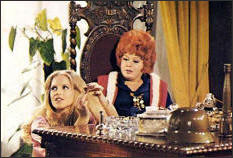
(right) Winters as the lesbian, "Mama," in Cleopatra Jones
And speaking of the bars...bottled beer disappeared about the mid-Seventies, I guess, and bars started serving beer in cans. Opening cans in a busy bar by punching the holes with an old fashion "church key" opener was a pain in the ass. In the brief era before pop-top cans appeared, bars installed huge levered can openers which looked like something from a 1930's metal stamping factory on the bar counter. These punched two holes in the can tops easily and quickly, and now and then sprayed beer over everyone within three feet in the device.
After I stopped going to the Continental Baths, I never hit the baths again. But while the Continental closed as a gay baths, the Everard and the St. Marks did a roaring business, and new baths opened up. I remember hearing of Man's Country and the Club Baths, but there may have been others I've forgotten.
OUR FOURTH ESTATE

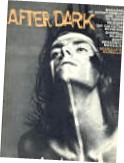 A
magazine called After Dark (1969), a straight publication
only by virtue of the fact it would not say that it was
a gay one
was doing a booming business.
It's presentation was definitely geared to appeal to gay men, despite no overt
acknow- ledgement that it was intentionally doing so
this supposedly at the insistence
of it's publisher, Jean Gordon, who also put out Dance magazine. Gay restaurants, bars
and stores advertised in it, though the word "gay" was not allowed in the ad
copy. Many of the photos
regardless of subject matter
were extremely
homoerotic whenever a male body was in the picture, which somehow seemed to be
more often than not. After Dark was in love with steamy, sleazoid Warhol superstar, and
former beefcake model, Joe Delassandro. But then even the straight world was
intrigued by him. One of the regularly featured photographers was Kenn Duncan,
and his top-notch photos of celebrities and any ol' hunky
actor-singer-dancer-waiter were a hallmark of the magazine. In fact, they
came close to being the hallmark in my estimation. (Google "kenn duncan
photography for a quick look.)
A
magazine called After Dark (1969), a straight publication
only by virtue of the fact it would not say that it was
a gay one
was doing a booming business.
It's presentation was definitely geared to appeal to gay men, despite no overt
acknow- ledgement that it was intentionally doing so
this supposedly at the insistence
of it's publisher, Jean Gordon, who also put out Dance magazine. Gay restaurants, bars
and stores advertised in it, though the word "gay" was not allowed in the ad
copy. Many of the photos
regardless of subject matter
were extremely
homoerotic whenever a male body was in the picture, which somehow seemed to be
more often than not. After Dark was in love with steamy, sleazoid Warhol superstar, and
former beefcake model, Joe Delassandro. But then even the straight world was
intrigued by him. One of the regularly featured photographers was Kenn Duncan,
and his top-notch photos of celebrities and any ol' hunky
actor-singer-dancer-waiter were a hallmark of the magazine. In fact, they
came close to being the hallmark in my estimation. (Google "kenn duncan
photography for a quick look.)
After Dark, folded in the early 1980's as openly gay magazines made it obsolete as erotica, and new, hipper straight magazines provided trendy arts and entertainment articles Rolling Stone, Crawdaddy, and Andy Warhol's Interview, etc., etc.
 Colt
Studios, first located in NYC, was publishing a series of slick new magazines
Manpower, Gallery and Olympus are three I remember from the early Seventies.
Colt
Studios, first located in NYC, was publishing a series of slick new magazines
Manpower, Gallery and Olympus are three I remember from the early Seventies.
Colt Olympus 1975, Gordon Grant on cover
A whole crop of new homoerotic magazines like In Touch ('73), Mandate ('75) , Drummer ('75) and Blueboy ('75) had eventually pushed the closety After Dark into a terminal slump. And not to forget the "straight" Playgirl ('73), which had taken it's cue from Playboy, of course, but which had a veeeery large gay male readership, though "lookership" was more accurate, I don't know that many guys were actually reading it.
Gay magazines ranging from the homoerotic to almost hard-core were now found in almost every newsstand and magazine store in Manhattan. And sometime in the mid-Seventies The Advocate became a national publication. Gay, the Screw sponsored paper, folded which was a shame, as it was a quality effort. But there was yet another gay paper, whose name I can't remember. The Village Voice had regular gay contributors now.
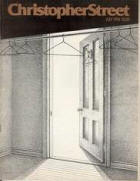 Christopher Street debuted in 1976.
The publication was an
attempt at a serious literary gay magazine, with quality essays, short stories
and feature articles by heavy-weight contributors. It struggled on for some
years without ever becoming a commercial success
unfortunately. Regrettably,
it
ceased publication in Nov/Dec '95.
Christopher Street debuted in 1976.
The publication was an
attempt at a serious literary gay magazine, with quality essays, short stories
and feature articles by heavy-weight contributors. It struggled on for some
years without ever becoming a commercial success
unfortunately. Regrettably,
it
ceased publication in Nov/Dec '95.
First issue of Christopher Street, July '76
 What
were referred to as "bar rags" flourished. These were cheap little magazines
given away to patrons in gay bars around the city and featured "news" about
bars and their customers.
What
were referred to as "bar rags" flourished. These were cheap little magazines
given away to patrons in gay bars around the city and featured "news" about
bars and their customers.
(right) July '74 issue of Michael's Thing
Michael's Thing was probably the best known and longest lived one. They were considered a joke by most people and read mainly as ludicrous camp. One bartender on the Upper West Side used to give impromptu readings from behind the bar when a new issue came out.
A major high point of gay journalism in the city during this era occurred May 23, 1974 on the occasion of the gay rights bill going down to defeat in the City Council for the third time (or was it the fourth?). Arthur Bell, a gay reporter for the Village Voice at the time, I believe, kicked anti-gay councilman, Mathew Troy in the shin, and Councilman Troy returned the favor by slapping Bell in the face. Pu-leeez, shades of Gore Vidal and William Buckley! I mean, a mud wrasslin' match might have been hot, but this? More decorously, there was also a sit-in at St. Patrick's Cathedral by gay protestors, as of course the RC's were the major source of anti-gay lobbying on the issue. However, groups of Orthodox Jews were always extremely vociferous opponents of the bill, too.
This same year gay people did better when Elaine Noble an out lesbian was elected to the Massachusetts legislature in November '74 and in Catholic, Home-of-the-Puritans Massachusetts too.
ME, ME, ME
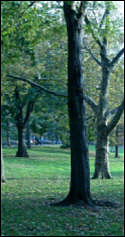 My new studio
apartment on West 80th St. was awfully small, but it did have a
major bonus for a NYC apartment: a beautiful view through the trees at the north end
of the Museum of Natural History to the Planetarium. And though our building
had been chopped up after WW II to make many smaller apartments, the renovators
had made the new walls as thick as the old, so that the building was close to
soundproof. Except for that brief stint after Larry Coulter left the House of Flowers
this was my first time living alone in Manhattan for any length of time.
My new studio
apartment on West 80th St. was awfully small, but it did have a
major bonus for a NYC apartment: a beautiful view through the trees at the north end
of the Museum of Natural History to the Planetarium. And though our building
had been chopped up after WW II to make many smaller apartments, the renovators
had made the new walls as thick as the old, so that the building was close to
soundproof. Except for that brief stint after Larry Coulter left the House of Flowers
this was my first time living alone in Manhattan for any length of time.
It was only a few minutes walk, down to the Pic and the Candlelight on Amsterdam Ave. in the mid-West 70's (and later other new bars, which stayed centered in the lower West 70's.) But following the strong advice of my friend Don and the super, Bob, I did not turn right when I left the building and walk down our West 80th Street block to reach Amsterdam.
(below) back corner of the Museum of Natural History
 Instead I turned right and
walked down Columbus Ave. one
block to West 79th, a wide cross-town street, and then across it to reach Amsterdam. While this was
absolutely safer, doing it was a constant
reminder that I had moved back into a different world from the gentrifying Upper West
Side only a little more than half a dozen blocks south. On the other hand, I
almost never shopped in a large supermarket. Instead, I used the little Puerto
Rican bodega on the ground floor of our building or one of the others in
the area every day, which had the effect over time of making me more
comfortable with the neighborhood, but not less careful.
Instead I turned right and
walked down Columbus Ave. one
block to West 79th, a wide cross-town street, and then across it to reach Amsterdam. While this was
absolutely safer, doing it was a constant
reminder that I had moved back into a different world from the gentrifying Upper West
Side only a little more than half a dozen blocks south. On the other hand, I
almost never shopped in a large supermarket. Instead, I used the little Puerto
Rican bodega on the ground floor of our building or one of the others in
the area every day, which had the effect over time of making me more
comfortable with the neighborhood, but not less careful.
My social life and my friends remained the same. However, I had learned from the affair with Ken, and I was not in the market for a simulation of the heterosexual moon-June-honeymoon-cottage-for-two with another guy. Perhaps because I'd had no siblings, my friends meant a great deal to me, and that kind of fraternal/buddy relationship was more of a magnet to me than a spin-off of the married het couple was. I slept with tricks from the bars, though often with the same ones repeatedly. And I had also been sleeping with two of my friends often Don P., who gave me the lead on the apartment in the building, and Charlie Collins, a friend I'd met at the Candlelight two or three years before.
Charlie and I often went out for dinner together, and to the bars as well. Sometimes on a night out one of us would pick up a trick and we'd split, other times we'd have threesomes, and quite often we'd end up just screwing with each other. Lots of guys would freak out at the idea of fucking with a friend. For several years Charlie was my best friend, and we didn't have a problem about it. Consider this, if you can't screw with a friend, what the hell kind of trash are picking for friends?
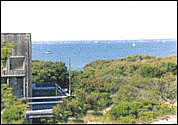 I
continued to go to the Fire Island Pines for a few summers, renting on a Sunday
through Friday basis from people I knew. Don and I went out
together once, but usually I went alone. Rather unbelievably, I never once
picked anyone up while I was out there
and it was for lack of trying.
I was always lucky that the people I rented from had nice secluded houses,
surrounded by trees and located on the bay. I was happy to be in a gay
environment, but for me it was a time and place away from the stress, and
concrete, of the city
and it didn't have to be fucking Walden Pond. I'd take three or four books along, get up early in the morning to shop, spend
the day on the beach or on the deck, walk up to the harbor in the afternoon and
then make dinner and pack it in by ten o'clock. Although, I expect that if I
hadn't had an abundant and satisfactory sex life in the city it would have all
worked out differently.
I
continued to go to the Fire Island Pines for a few summers, renting on a Sunday
through Friday basis from people I knew. Don and I went out
together once, but usually I went alone. Rather unbelievably, I never once
picked anyone up while I was out there
and it was for lack of trying.
I was always lucky that the people I rented from had nice secluded houses,
surrounded by trees and located on the bay. I was happy to be in a gay
environment, but for me it was a time and place away from the stress, and
concrete, of the city
and it didn't have to be fucking Walden Pond. I'd take three or four books along, get up early in the morning to shop, spend
the day on the beach or on the deck, walk up to the harbor in the afternoon and
then make dinner and pack it in by ten o'clock. Although, I expect that if I
hadn't had an abundant and satisfactory sex life in the city it would have all
worked out differently.
When
Ken and I had been living together, Ken tricked with Stanley, who lived over by
Sutton Place and dealt grass for the major part of his living. When I moved out
on my own Ken had introduced me to Stanley, and I began buying from him. Friends commented that I always had grass, and that it was always good
would it be possible to fix them up with my contact? I was surprised and
pretty naοve, I guess when Stanley was not enthused about acquiring these new
customers I was about to hand him on a silver platter. It had not
registered with me that
 even though Stanley had met me before, after Ken told him that I wanted to start
buying
from him, Stanley had been very lukewarm about making an appointment at
first.
even though Stanley had met me before, after Ken told him that I wanted to start
buying
from him, Stanley had been very lukewarm about making an appointment at
first.
a Z of grass
The problem was that while he wanted the income at $35/Z you needed to sell a fair amount but he did not want more and more traffic in and out of his small building and up to his apartment. What he preferred was big purchases. Stanley urged me to cop for my friends, i.e. they'd give me their money and I'd pick up their grass each time I went for myself. However, this arrangement meant carrying back more dope than could ever have been claimed was just for my own use in the event I got busted not smart.
I had been going to Stanley's place a couple of years, perhaps, when I noticed the addition of a pharmaceutical scale to his office decor. Once when I arrived he was weighing out coke for a straight female customer (though he was gay, he was an equal opportunity vendor.) The two of them tooted and he offered me a line, but I declined. I'd never had coke, and being on my lunch hour I was not about to start experimenting. He later tried to sell me some at $125/gram, as I recall but I had no interest, and even if I had had, not that kind of cash. As far I knew cocaine was a society/celebrity drug, and though I heard mentions of it once in a blue moon no one I knew personally used it.
Finally, in late spring 1973 Ken had decided to take the big leap and open up a restaurant. He sold his half of the PR partnership to the other partner, and after working in a restaurant kitchen on Long Island for the necessary hands-on experience, he headed to Houston. He had a place there for several years, and then went to California where he opened another.
I did not want to work for his partner, and I split
too. As summer is a lousy time to look for work, I took a temp job at the
Central Office of the City University to tide me
over until post-Labor Day job-hunting. Twenty years later I was still there. I showed no
such attachment to my studio apartment, which by now seemed smaller than ever.
And sleeping on a fold-out sofa-bed was like penance. In the fall of the year I
moved into a nice sized one-bedroom apartment on the seventh floor, located in
a corner of the building with a view of the back of the museum and down the long
sweep of Columbus Avenue.
NICHIREN SHOSHU BYWAY
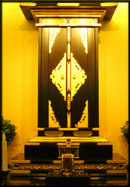
Don P. had to work out of town for awhile, and he rented his apartment upstairs to Mike, a friend I had known from the downtown gay bars in my senior year at Syracuse U. and who had briefly been my roommate on West 81st Street in the mid-Sixties. Though he had been raised a Catholic and had remained a nominal (and guilt-stricken) one, I was surprised to find that he had a new set of friends and a new religion. It was Buddhism, or at least seemed that it might be a kinda, sorta Buddhism. Mike's explanations were wrapped in the doctrinal zeal of the convert and short on bare bones facts. However, after listening to him enthuse about it a few times a light went on in the back of my mind.
About ten years before I had picked up a copy of Look magazine (the rival to Life) while in the dentist's office. Since it was the occasion of my first root canal, I never forgot the visit, nor the article I had looked at. The subject was a religious sect called Soka Gakkai (Value Creation Society), a popular post-WW II Buddhist organization in Japan which was a lay run offshoot of the indigenous Japanese sect of Nichiren Buddhism. I recalled the historical Nichiren tradition from Dr. Bro's beautifully taught World Religions course at Syracuse, but this sect was a new development.
The point of the Look article, however, was its quiet growth in the United States. It had gotten its start when it had been introduced to a few American service men by their Japanese wives, and these men in turn had proselytized fellow soldiers, and then family and friends when they returned to the U.S. At the point when the Look article was written it was characterized as having many black and poor working class white adherents here. Soka Gakkai emphasized the individual's power to change his or her life for the better through the organization's ritual; very aggressive proselytizing by lay people (a characteristic extremely at odds with traditional Buddhism); and stubborn insistence that its understanding is the only True Buddhism. Quite contrary to traditional Buddhist attitudes the sect encouraged the avid pursuit of wealth, power, personal happiness and political power it was not unlike the prosperity cults and ministries which sprang up on the fringe of evangelical Protestantism. Once established in the U.S. it began to attract mostly young professionals.
However, as Mike talked about it what came to the forefront were the problems that his gay friends were having in the organization. It seemed that they were being told that homosexuality was a barrier to the benefits that the practice would bring, and only by following a straight and preferably a married life could true progress be made and success in life achieved. As a result several of the more dedicated ones were (rather unhappily it sounded like) considering marriage to women they had met in the organization. I found the "get married" attitude toward homosexuals (and their potential spouses) not just ignorant but ruthless, and the group's departures from what I had learned about traditional Buddhist values in college made it appear suspiciously grasping and slick. I turned Mike's proselytizing button firmly to off.
A few years later Mike and I lost touch with each other, but I did hear about the organization once in awhile. It was called NSA for a time (for Nichiren Shoshu something - America, perhaps) and was evidently prospering. It entered the limelight much later when Tina Turner joined after escaping an abusive relationship with her husband and started her career anew, and other celebrities, e.g. jazzman Herbie Hancock, also were members. In the late Eighties I again met gay men involved in it, and homophobia was purportedly not an organizational issue now.
In 2001 the president of the organization (now called Soka Gakkai again), President Daisaku Ikeda sent the following greeting to an alternative lifestyles conference:
"My heartfelt congratulations on your Gay, Lesbian, Bisexual, Transgender and Supporters Conference! I ask that all of you who have gathered today please enjoy your dialogues and encourage one another to your hearts' content, so that you may move forward through building a network of human harmony.... All human beings have equal rights. There is no difference whatsoever in their inherent dignity. So no matter what you may face, please live with pride, confidence and courage...Please be true to yourself and live free, for you all embody the Mystic Law."
Perhaps somewhere among the gay followers of this organization Mike and his friends from the early Seventies were finally able to live happily in its embrace.
WHEN DID IT START?
One evening in the mid-70's some guys I knew who had
opened a new disco and club, Les Mouches, were batting around the question: When did
it start?
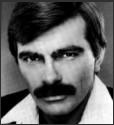 The consensus was that it all came together the summer of '74 at the Sandpiper in the
Pines.
The consensus was that it all came together the summer of '74 at the Sandpiper in the
Pines.
(right )Tom Moulton
A string of DJ originals from Francis Grasso on to the tapemeister, Tom Moulton, had invented a new art of playing dance music over the period of a few years turntable techniques, sound system design, the sequencing and segueing of individual recordings into a musical experience creating and re-creating a night-long aural ambience. By that summer there was not just the music of the Supremes and the rest of the Motown stable; plus Aretha Franklin and a myriad of other black performers who recorded soul and funk music which tended to have a strong, heavy beat and an urgent gospel-derived vocal style.
Now there was another sound: lushly instrumental, theatrically sexual and with a steady pulsating beat.
It was Love's Theme by Barry White's Love
Unlimited Orchestra that became the final ingredient: disco precipitated as
seamless sensuality teasing the mind/body duality to luscious, ecstatic
extinction.
White almost created a musical genre of his own. His female group, Love Unlimited, had a similarly orchestrated number Under the Influence of Love from the same album as Love's Theme. And White himself had had a heavily orchestrated success, Never, Never Gonna Give You Up, the previous year, followed by Can't Get Enough of Your Love, Babe and You're the First, the Last, My Everything in 1974.
All the ingredients were there now.
(I thought this stuff was honey-coated
popcorn compared to my usual tastes in the current black music scene, but
I
confess
at the same time, I couldn't resist it either.
The grass I was getting was super-good, maybe that explains my fall from musical
grace.)
By '74 the Sandpiper had become the trend-setting spot on the Island; and that may have helped spread the disco environment and the rapidly changing music sound far beyond the NYC area. The "Tea Dance", more usually just "Tea", took place at the Boatel (John Whyte's restaurant just down the walk a few steps from the Sandpiper). Hundreds and hundreds of gay men went there for drinks and dancing late in the afternoon and it broke up at about sevenish, as I recall. The Sandpiper was still a restaurant, and clearing away its dinner tables for the evening dancing that went on there until closing. But by this time gay men were beginning to abandon the custom of eating their evening meal out, and preferred to go home after Tea for a nap, have dinner in and then head down to the Sandpiper late at night.

The Sandpiper in the late 70's
(photo: courtesy of Robbie Leslie)
The Pines catered to a more moneyed population, both gay
and straight, and it got a fair smattering of European, Canadian and South
American gay men who spent at least a part of the summer there. During the
70's and 80's I met several gay foreigners who spoke of first dancing to black
music in the Sandpiper in the mid-Seventies. And some had recorded music off
of the NYC radio stations to take back home and play. WBLS surfaced in '74, and
I can remember one Italian guy who told me that he recorded dozens of tapes during a visit that year, and when he played them on the beach in Italy people
went crazy for the
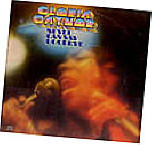 super-cool
black BLS sound. However, in addition to gay men the Pines did get some
straight people with bucks, and they used to be a tiny minority at the Sandpiper
in these early years
they, too, may well have taken a taste for disco with
them wherever they went to for the winter.
super-cool
black BLS sound. However, in addition to gay men the Pines did get some
straight people with bucks, and they used to be a tiny minority at the Sandpiper
in these early years
they, too, may well have taken a taste for disco with
them wherever they went to for the winter.
(right) cover of Gloria Gaynor's album Never Can Say Goodbye
That same year Fly Robin, Fly, Lady Marmalade
and Shame, Shame, Shame came out. And in December
Gloria Gaynor debuted with a Tom Moulton produced
album, Never Can Say Goodbye
it contained three songs, each one an
extended dance number. The album was a hit, the songs were hits and the lady
became a national star overnight, and helped launch disco into the mainstream
consciousness.
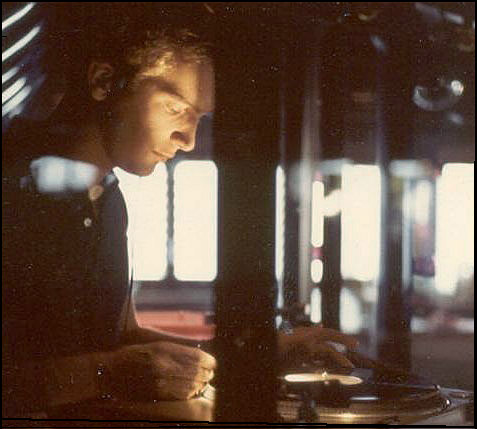 We would not stop dancing. We moved with the
regularity of the Pope from city to Fire Island in the summer where we danced
till the fall, and then, with the geese flying south, the butterflies dying in
the dunes, we found some new place in Manhattan and danced all winter there.
We would not stop dancing. We moved with the
regularity of the Pope from city to Fire Island in the summer where we danced
till the fall, and then, with the geese flying south, the butterflies dying in
the dunes, we found some new place in Manhattan and danced all winter there.
excerpt
from Dancer From the Dance
by
Andrew Holleran
DJ Robbie Leslie at the Sandpiper, late 70's (photo courtesy of Robbie Leslie)

I was coming back from an Easter weekend at the New Jersey seashore with a white gay friend. Russell was driving and as we got closer to New York City I was trying to bring in any NYC station clearly on the radio. He said, "Put on BLS." I had no idea where WBLS was on the dial, I'd never heard of it. He was very surprised, because he knew my preferences in music. Russell found it and we listened the music, the mix, the style....it was like being in a really good gay dance environment, except that it was ostensibly pitched to a sophisticated black audience. Russell grinned, I was in love with it already. And so too was the rest of gay New York. There were competitors. I never listened to them.
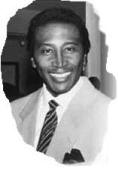 WBLS
had appeared in '74, after changing its call letters from WLIB-FM, an urban
contemporary (R&B) station. Under the aegis of Frankie Crocker it quickly
developed into the coolest urban music station in the area
it was often the
number one rated FM station in the city from 1974 to 1978. Its style was
smooth, flawlessly cool and a flow of seemingly never-ending music, and even the
commercials began to be designed to segue in with the musical playlist.
Many times you were into a commercial break before you realized that a set had
WBLS
had appeared in '74, after changing its call letters from WLIB-FM, an urban
contemporary (R&B) station. Under the aegis of Frankie Crocker it quickly
developed into the coolest urban music station in the area
it was often the
number one rated FM station in the city from 1974 to 1978. Its style was
smooth, flawlessly cool and a flow of seemingly never-ending music, and even the
commercials began to be designed to segue in with the musical playlist.
Many times you were into a commercial break before you realized that a set had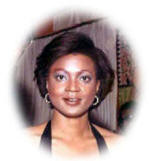 ended...the weather, traffic, station ID
it all moved to a beat. The
station's DJs became a kind of galaxy of stars of urban sophistication. WBLS presented its music, its commercials, its DJ's as a Total Package
it was theme music for life.
ended...the weather, traffic, station ID
it all moved to a beat. The
station's DJs became a kind of galaxy of stars of urban sophistication. WBLS presented its music, its commercials, its DJ's as a Total Package
it was theme music for life.
Frankie Crocker :
"If we're not on your radio, your radio isn't on"
Lamarr Renee
Twenty-four hours a day - Life, the movie, starring relentlessly cool You.
One of the female DJ's, Lamarr Renee, had a prime night time slot. Gay men were wild about her. The gay phenomenon was something the station management had a bit of difficulty dealing with, I've heard. However, it was clear that white gay men were fueling the popularity of disco music and of the station as much as young black people were. And the DJ's at gay dance venues were heavily influencing what got onto the charts, which had formerly been a power exclusive to the radio DJ. Whatever his personal feelings might have been, Frankie Crocker found it professionally savvy to keep in touch with what was happening with these guys. And later he would a regular visitor in the DJ's booth at the Paradise Garage to pick up on what Larry Levan was putting together.
WBLS did accommodate itself to its gay listeners by degrees though. There were still a few programs with listener dedications, and it was clear from these, to anyone gay that the listening audience had a large number of males in heavily gay white neighborhoods. Subtle gay-oriented references began to crop up in the DJ patter, an increasing number of commercials for items and services appealing to gay males were aired, references to events and clubs for gay men multiplied. In a few short years when disco music and dancing had clearly swept all before it, the station began a once-a-week feature program of commercial-less taped music called "Disco Party", which played music mixed and taped by the DJ of some popular disco. Amazing to me, the kick-off night of this format was "brought to you from the Crisco Disco". The Crisco Disco!? The Crisco Disco was one of the wildest clubs in the city, known not only for its DJ's and their music, but notorious for heavy drug use and the raw sexual atmosphere of the place. The straight black audience may not have been aware of it, but this was a clear acknowledgement of the fact that gay men were major trend makers in dance music.
In 1976 the Quiet Storm program format was created on a Washington, DC station, and it soon became the late-night slot on WBLS with DJ's Vaughan Harper and Jerry Bledsoe. For those who don't know, Quiet Storm is a blend of R&B and jazz influences. It featured eclectic mixes like Nancy Wilson, the Isley Brothers, Jimmy Scott, Teddy Prendergrass, Ashford & Simpson, the Jones Girls in a single set. (Rhino has produced a master anthology called Smooth Grooves, which compiles this type of music into several series of albums - Smooth Grooves, Smooth Jazz, Jazzy Soul, Smooth Grooves - After Hours.) And Quiet Storm dropped right into the gay listening experience it was music for dinner, music for blowing grass, music for sex-all-night. And it should have been the music for that night in the brass bed with Mario Amaya, with the curtains blowing in the wind and the rain glistening on the marble floor at dawn.There were those rare weekend nights when I'd light up a joint before going out - always a mistake and get so mellow and into listening to BLS that I didn't make it to the front door. Saturday nights if I didn't trick, I'd often put on the Quiet Storm when I came in and smoke a joint before turning in around four a.m. or so. If my roommate, Tom, came in alone before I hit the sack, we might stay up listening to BLS, toking joints and talking till dawn.
This is probably the appropriate place for a confession: I was totally unaware of the term "punk rock" and the music it described. Totally. And I don't recall anyone I knew, even those guys half a dozen or more years younger than myself, having any interest in it. In retrospect the phenomenon was part of what I heard as the mass of music-noise designed to accompany the angst of straight, barely post-adolescent white boys from the suburbs and small towns of the Trans-Hudson Outback. Fifteen or more years later I was friendly with someone associated with the Ramones, and it was only at that point that I became truly aware that there was something called Punk Rock. Mea culpa, mea culpa, mea maxima culpa...I guess.
CONTINUATION: The Juicy Life, Part II (with Links)
email to: nycnotkansas@gmail.com